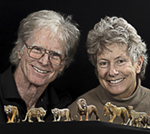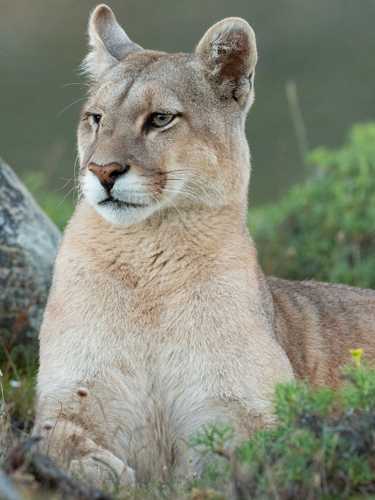
Blinka, one of the most habituated of our Pumas
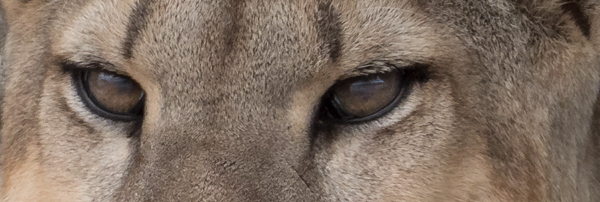
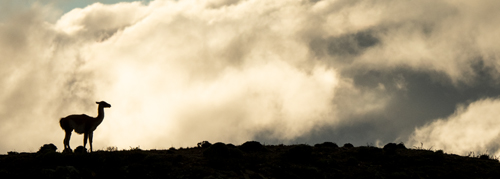
Guanaco - the Puma's principle prey
Chile 2018
The Pumas of Torres Del Paine – The Wildlife Tour
TRIP REPORT
Although we may work harder and are far more physical on this trip than any other, this Photo Tour is one of our all-time favorites. Nowhere else in the world can one be on foot, close, to a Big Cat, at least by still doing it safely. Mary and I have been visiting this area for over 15 years, on our own personal quest to photograph Pumas. After many years of dogged trying we were finally successful, and with our success we began Puma tours, in conjunction with our guide and outfitter, who was the pioneer in habituating Pumas. Although more people now visit and seek out Pumas than ever before – when we started, our group with our guide was the only one, and now Pumas are more accustomed to people than ever before, making the shooting much easier than it was when Mary and I started.
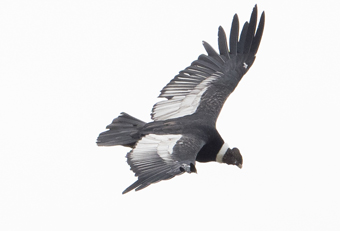 Our two trips involved a total of 11 days in the field. On our first Photo Tour we had 27 Puma sightings, and on the second, I don’t really know, as I stopped worrying about numbers once we passed 20, and in total we had over 50 sightings, with perhaps 18 different Pumas, in an area less than fifty square miles – 10x5 miles at most.
Our two trips involved a total of 11 days in the field. On our first Photo Tour we had 27 Puma sightings, and on the second, I don’t really know, as I stopped worrying about numbers once we passed 20, and in total we had over 50 sightings, with perhaps 18 different Pumas, in an area less than fifty square miles – 10x5 miles at most.
In contrast to previous trip reports, the two that follow were written, mostly, at the conclusion of each tour. I simply didn’t have the time or energy to do more than download in the little free time we had. While this type of schedule might seem exhausting, and it is, no one complained, as the time afield was so incredibly productive.
For the first time, ever, Mary and I shot Olympus cameras exclusively. We brought some of our Canon gear as backup, or insurance, but never used the Canon gear. On our first three days I carried a 5D Mark IV and my favorite lens, the Tamron 150-600, in my pack, but didn’t use it. Finally, one afternoon as we waited for a Puma family to wake up and play I decided to try some high-speed video (119fps) with my 5D as the Pumas played. There was a stiff wind, and the camera and lens vibrated so badly that after only a few seconds I switched back to the Olympus. The Zuiko 300mm I was using was far smaller, and solid, and with 6 stops of built-in stabilization, I shot steady video, while Mary enjoyed the same as she shot stills.
This was the defining test for us, whether we’d be switching to Olympus gear or not, and Olympus passed our test. In another post – probably a Question of the Month – I’ll explain all of the reasons why. In the meantime, here’s the trip report, mostly illustrated with Mary’s photos.
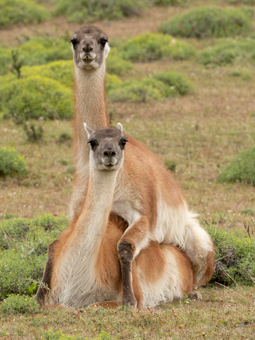
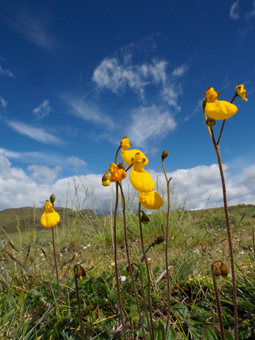
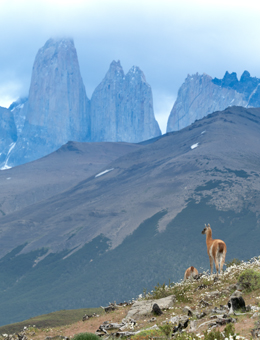
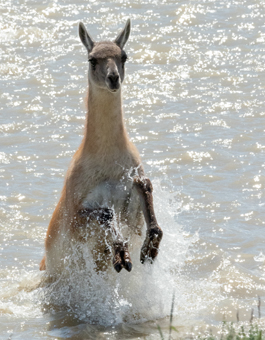
Check out my first of several video from the trip –
Training Day – Young Pumas learn to hunt.
Here's the Reports:
Our first tour has ended, and only now do I have any time to recount a Trip Report 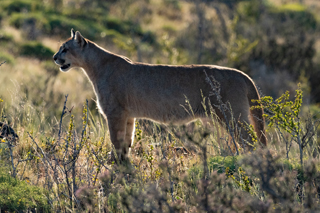 --- the days were that full, and exhausting. Our days began with a departure from our lodge at 4:45AM, a return sometime after noon, and another game drive in the afternoon that began around 5PM and continued beyond 9PM, and sometimes closer to 10PM. With a late meal, shower, and repacking for the following day, it was rare that we were in bed before 11PM, and sometimes much later.
--- the days were that full, and exhausting. Our days began with a departure from our lodge at 4:45AM, a return sometime after noon, and another game drive in the afternoon that began around 5PM and continued beyond 9PM, and sometimes closer to 10PM. With a late meal, shower, and repacking for the following day, it was rare that we were in bed before 11PM, and sometimes much later.
That’s less than four hours sleep a night, buttressed most days with some type of nap after lunch, which for the lucky ones who could sleep might add another two hours or so. Sound’s like fun, right?
Well, considering that we had 14 different Pumas, and 27 encounters in total, it was all worth it. Without question, it was the most productive trip we’ve ever had for Pumas, as well as for Patagonian Gray Fox, and the usual good shooting for Guanacos, Condors, and other species.
Our first game drive set the tone, and raised the bar so high that my friend and in-country guide worried that we may have created a false impression as to really how difficult it can be to have a good Puma encounter. After driving from Punta Arenas, meeting our guide in Puerto Natales and transferring our luggage to our vehicles, we continued on to our lodge, unpacked, and after a short break headed into the field.
Our spotter was already out there, positioned at a location where he could scan a large area. When we arrived, our group began a leisurely walk towards his position, but that calmness soon changed when our spotter radioed us, informing us that he had two Pumas in sight! The walk was now fast, with everyone who had not been with us previously (all but one) walking as fast as they could towards the spotter.
When they arrived, a Puma was walking away, and our guide was calling everyone to join him for a better angle, while most just stopped and started shooting, excited at seeing their first Puma in the wild, and of getting an insurance shot. Things were about to change.
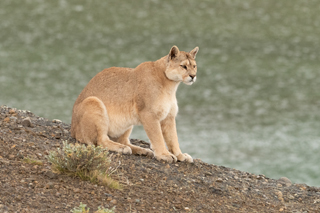
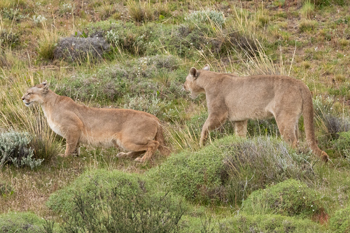
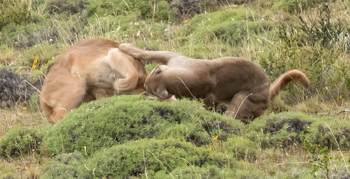
_060652.jpg)
_060671.jpg)
_060690.jpg)
After posing on a ridgeline, one of two females walked pass us where she was eventually joined by her sister and the male Puma. The female was in heat, but the male wasn't ready, and despite numerous presentations never attempted to mate.
We soon learned that there was another Puma in view, walking towards the first. Then, we found that a THIRD Puma was watching us from a distant hill. Our Guide and spotter knew the female Pumas, and also knew that they were approachable, and so we advanced, slowly and carefully, but we were amply rewarded.
Six days after that encounter and I still can vividly remember the key events. Our first great shoot had the Puma lying atop a high cliff ledge, where we framed her against the loaf of bread shaped cliff faces, before she walked down, and sat, on another cliff with a backdrop of the emerald-colored lake. Later, this ‘first’ Puma walked straight towards us, only cutting to the right when it was nearly frame-filling, and then passing by only 40 or less yards away.
She was then joined by her sister, and then the male, which we first spotted far away on a hilltop. A female was in heat and ready to mate, and presented herself several times, but the male seemed unsure, and except for swatting at her, and doing the flehmen behavior, he did nothing but follow her. Still, watching this semi-courting, with the female sometimes chirping her call close to us, was exciting, and an incredible bar that we set for the remainder of the trip.
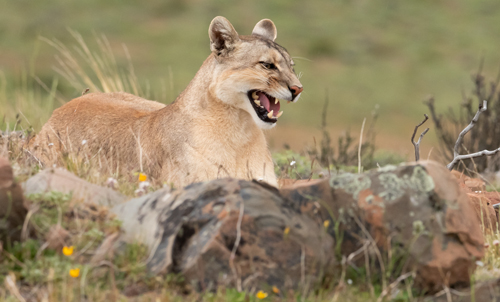
One of the females chirps, quite bird-like, in a contact call to her sister.
_060415.jpg)
But our Puma sightings only got more exciting. On a following morning we had a strange female Puma with two cubs – strange, because the cat has been seen for several weeks, sporting a weird, crippled, injured-looking gait that, when I saw it, I thought she was on death’s door and would have to be near death. Apparently, somehow, the Puma is surviving, perhaps aided by her nearly full-grown cubs that might be making the kills, or perhaps she’s scavenging and sharing kills with a daughter from a previous litter.
That afternoon, we found, for the first time, the mother Puma Sarmiento, who has three nearly full-grown cubs. The family were sleeping when we arrived, but after a 1.5 hour wait the cats woke up, and played and performed in the open grasslands below us. It was a stellar performance.
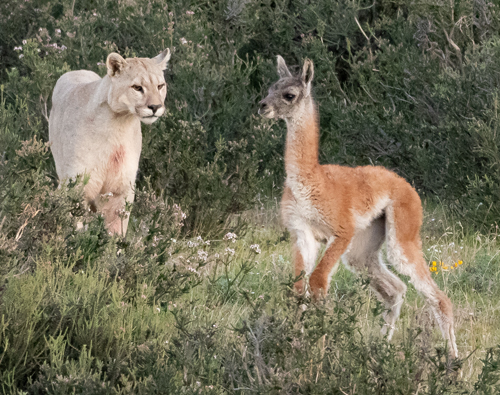
In the video you'll see how fast that Puma attack was. After knocking the guanaco calf down, the male Puma let it stand, and then chased it, sometimes tackling the calf, sometimes just half-heartedly swatting it, and eventually allowing the lucky calf to escape, where it joined its mother and the herd.
The following morning, Mary, our Guide, and my own field experience really came into play. We saw a group of Guanacos facing in one direction, whistling their alarm calls and slowly advancing, tentative, but obviously focused. We assumed a Puma was hiding, and probably had a kill. Mary then spotted what we thought was the kill, but turned out to be a live Guanaco baby that the Puma had slightly injured. We soon spotted the Puma, still playing with another baby it had captured. When our first baby Guanaco stood up, the Puma charged, but only grabbed at it, and then, as the baby ran off, the Puma took chase, sometimes knocking it down, and mostly just giving the baby a half-hearted swipe. Eventually they went over a ridge and we followed, to find that the baby Guanaco finally broke free and joined its mother, safe at last.
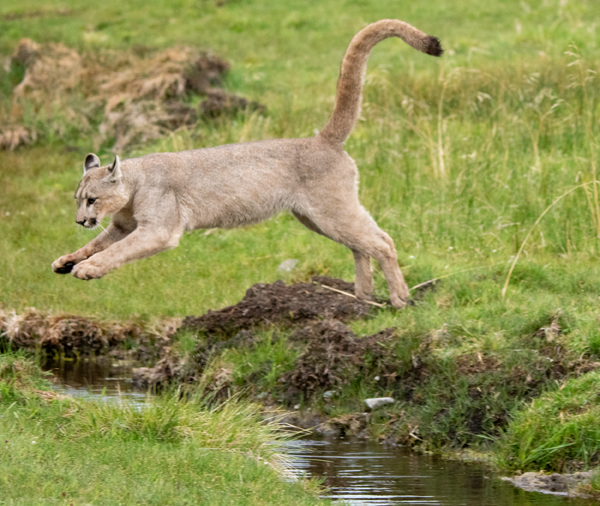
Other memorable moments included watching the same family of Pumas run down a hill after a Guanaco, then drink at a small stream before leaping across, directly towards many of our cameras. On another day, the same family walked by a lake, ducks in the background, and passed close by. We spent an afternoon waiting for a family of Pumas to wake up, hoping that they would begin to play before moving off to hunt. We were betting they'd do just that, utilizing an incredible theatre of open grass, and they did. The shooting was incredible.
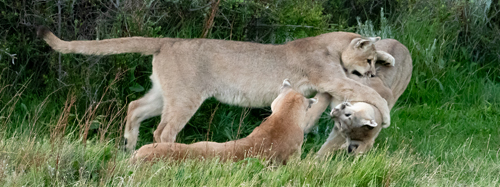
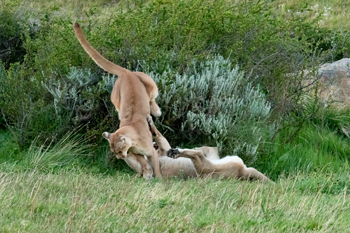
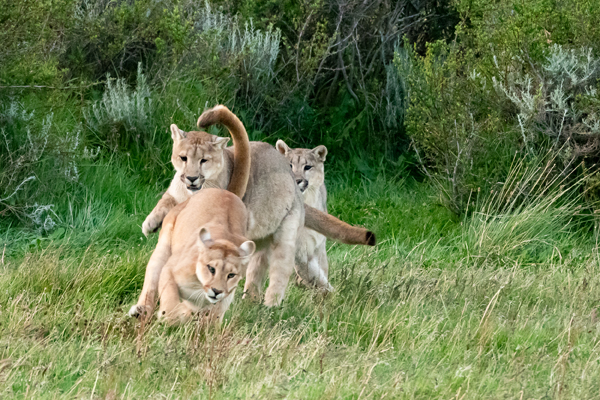
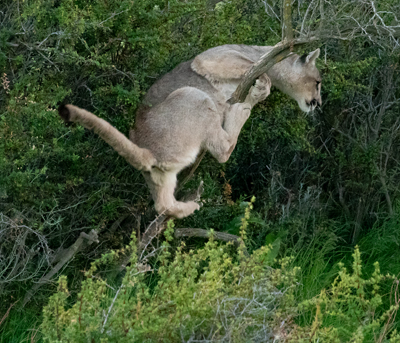
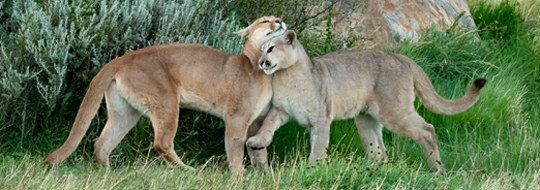
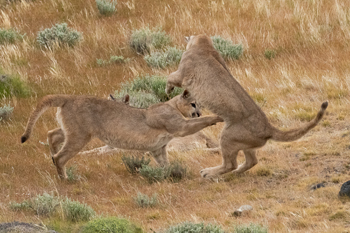
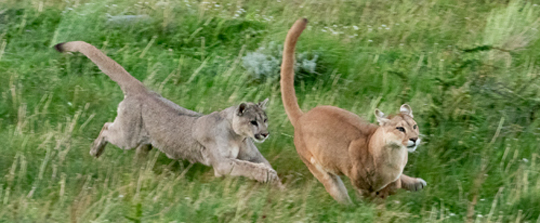
Our last day with Pumas began with a sighting of the family, and and concluded with a sighting of Blinka, the female with one bad eye. Two years ago I photographed the same Puma when she was just a cub, and she is tame. The Puma came within walking distance of the road, but settled in brush, and offered no shots, and we left her to sleep through the day.
In the afternoon, however, we returned, and followed the cat as she walked up hill, at one time walking right to me, passing within a few feet before pausing on the same ridge where I was standing, looking back at me from just a few yards. I was using too large a lens, and dropped by pack, slowly, to dig out a wide-angle. I got the camera up in time, but had the camera set on video, and as I tried snapping a shot nothing happened. By the time, seconds only, that I made the setting change, the Puma walked off – leaving me with an almost indelible image, in my mind, of the Puma on the ridge, looking over the Patagonian landscape in the late afternoon, with sharp shadows defining each hilltop and glacial erratic boulder lying before her.
We continued following her, until she stopped, as Guanacos were in the distance. For nearly an hour we watched, hopefully, as one of the Guanacos slowly walked closer, but never approached close enough for the Puma to try a hunt. During this time, the Puma was hidden from view, but just as we were about to leave the Puma stood, and walked towards us, settling by a rock. We approached, and finished a fantastic week of Puma shooting with our closest encounter yet, with the tamest of all the Pumas in the area, completely unfazed by our quiet, careful, and respectful presence. The light was failing, and the wind was kicking up in blasts, and we headed back towards our vehicles. I was last, and paused several times to look back, and say a word of thanks to Blinka, and, honestly, half-expecting her to get up and follow us. She didn’t, but watched us leave, her gaze never leaving our group as we finally disappeared from her sight.
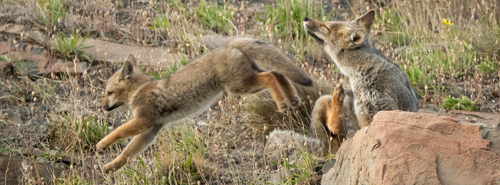
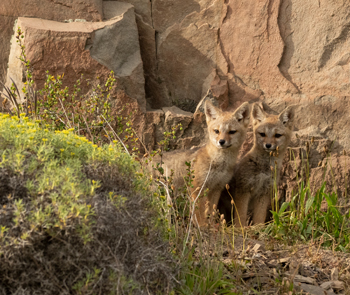
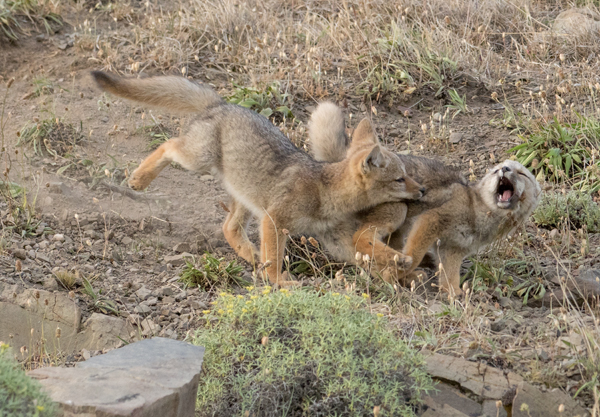
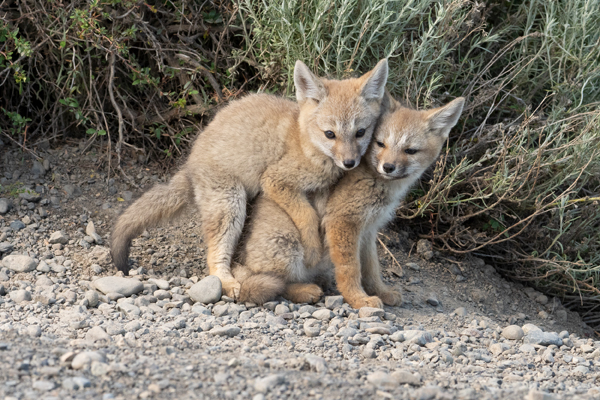
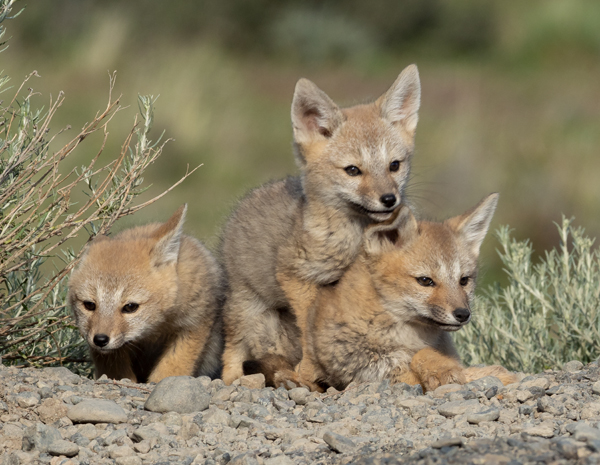
We had more fox dens than ever before, most of which we discovered on our tours.
Pumas were the focus of the trip, but we had incredible luck with Patagonian Gray Foxes, too. We found four different dens, with one providing a real drama. Mary and I were following our Guide’s vehicle, several hundred yards behind, when three small animals, yelping and screeching, suddenly rushed out on to the road right in front of me. Luckily, I didn’t hit any, and only after passing did I register what we had seen – three pup Foxes.
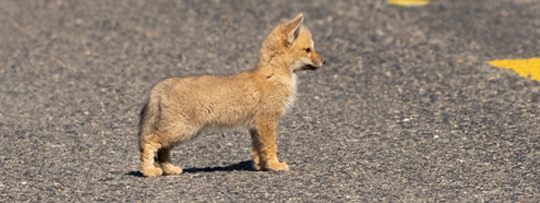
Mom Fox had, apparently, been trying to lead her pups to a new den (the old was on a bank right at one of the turn-offs). The mom Fox, a Vixen, would repeatedly run across the road, jump a small stream, turn around, jump the stream again, and either return to her pups or lie on the grass, or on the road, trying to get the pups to follow. At one point, the Vixen tried picking one up, but the pups were now too big and she couldn’t get a grip. Several times, we had to stop vehicles from speeding by, potentially smashing a pup or the Vixen as one or another would enter the road. Finally, the pups got tired and went back into the den, while the Vixen continued on to her new den, we think, perhaps to attend to pups that had already followed her. By the evening’s game drive the den was vacant … some time during our absence she successfully moved her family.
At another den we had first three pups, then five, appear on a back road. Shooting from the opposite bank, we watched as the pups came up to the bank of the road and played, with one pup repeatedly humping one of his nest mates. The entire show was precious.
At another den, high on a hill, we hiked up to check, but the pups disappeared. The Vixen wasn’t shy, and trotted by us, and found a nest of Southern Lapwings. The Fox would grab an egg, and run off, burying the egg before returning for another egg and doing the same. For the last egg, she stopped and ate it, while, all-the-while, the Lapwing pair dive-bombed and swooped at the invader.
Our final den provided an entirely different perspective, looking up at a rocky, cliff-side den where the dog Fox stood guard while the pups ran by, sometimes nuzzling their father.
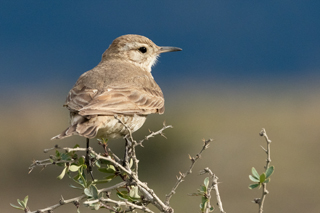
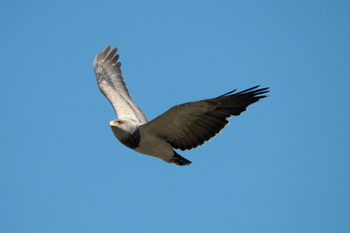
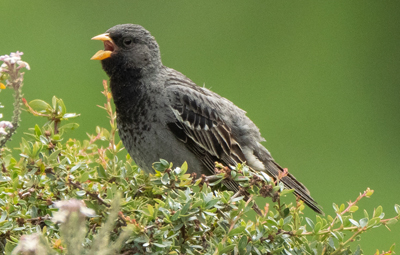
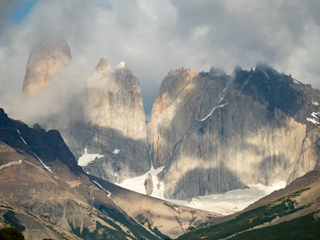
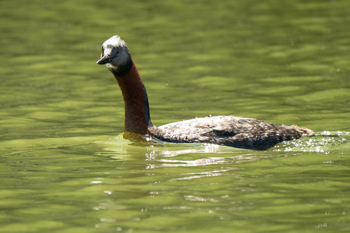
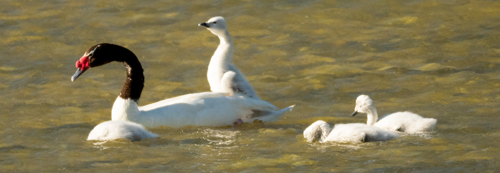
Top: Correndera Pipit, Black-chested Buzzard Eagle;
Second row: Mourning Sierra-Finch
Third Row: The Towers, Great Grebe
Bottom: Black-necked Swan
We had several passes with Andean Condors, sometimes with birds flying fairly low but often arriving so unexpectedly that we missed the closest passes. I found two large flocks perched – one after I climbed a hill where I’d seen Condors dropping, as if to land. That group immediately flew off. Another group, much closer to the road, were shootable, as we stayed in the vehicle and shot from the windows, getting decent images of a male with a full-fledged crest.
Guanacos were giving birth, but the peak seemed a week earlier, and we found several trashcan-sized placentas, which oddly enough I’ve never seen any animal scavenge. We saw young Guanacos, but no births, and on our last morning we were treated to some nice play activity.
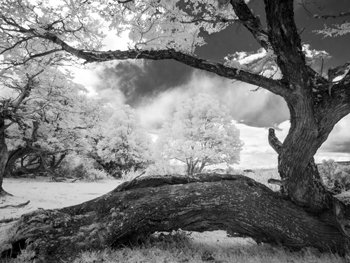
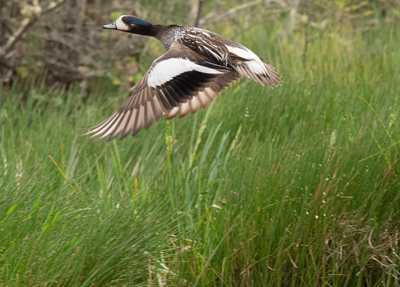
Infrared forest; Chloe Wigeon
One day we scheduled a day into the park, hoping to find Magallenic Woodpeckers, Huemuls, and Ringed Kingfishers. The Huemul is an endangered species of deer which is beginning to increase in numbers in the park, and at one location there is a very tame doe. We found her, and at times the issue was keeping far enough away for a shot, as the deer repeatedly walked up close. The Huemul doe now has what appears to be antler buds, and I’m wondering if the female, now 7 years old, may be losing her female hormones and manifesting testosterone symptoms, which might promote antler growth. In the US, Whitetail Deer does occasionally have horns, so the phenomenon isn’t unknown.
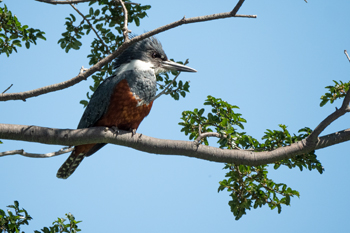 We did not find the Woodpecker, but did have a brief shooting session with South America’s largest Kingfisher, the Ringed. At that location we also had families of Ashy-headed Geese, a species we find, but infrequently, in the Falklands.
We did not find the Woodpecker, but did have a brief shooting session with South America’s largest Kingfisher, the Ringed. At that location we also had families of Ashy-headed Geese, a species we find, but infrequently, in the Falklands.
The weather was as variable as one expects in Torres del Paine, although we only had one morning with real rain, but by late morning that storm had blown through and we had sunny weather as we photographed Pumas. Wind was a constant, and sometimes, as we waited for Pumas to perform, conditions were brutal, but we also had periods of calm, and sunny weather that made afternoons down-right hot.
As I write this we just had dinner with our next group, and in surveying their desires, all but one had no goal except to photograph Puma. This we should do, with luck, but I stressed that after 9 or 10AM Puma activity teases, most days, and doesn’t resume until 6 or7PM. During the non-Puma hours we’ll be photographing everything, rounding out the incredible Torres experience. Earlier in the day, as rode our transit vehicle towards Punta Arenas, Mary and I slept the entire three hours – truly exhausted from a truly rewarding week. Now, we’re ready for the next one!
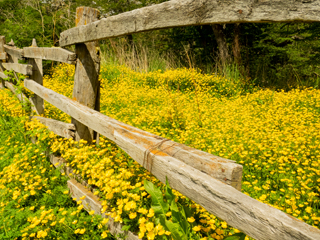
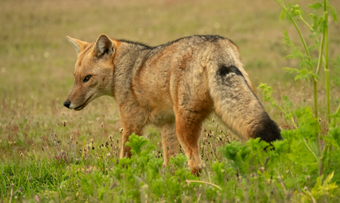
Top: Hand-held flower field at 1/20th sec.
Bottom: Culpeo, or Andean Red Fox
Trip 2
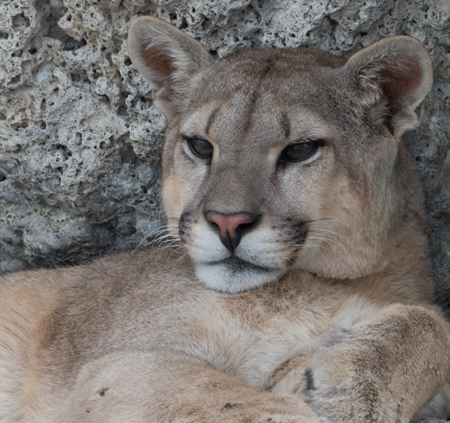 On our second trip I once again had little time to write a daily account, but even five days after our last time in the field the memories are fresh. Coming off of a great week of shooting, with incredible luck, I couldn’t imagine matching, or topping, the experiences we had on the first photo tour. We were so wrong.
On our second trip I once again had little time to write a daily account, but even five days after our last time in the field the memories are fresh. Coming off of a great week of shooting, with incredible luck, I couldn’t imagine matching, or topping, the experiences we had on the first photo tour. We were so wrong.
I must confess that I did not expect to have any luck on our first afternoon, despite the excitement and enthusiasm the five new-comers lent to the expedition. We cruised the Park road, scanning distant cliffs that were off-limits anyway, but hoping to at least spot a Puma to show the group. Mary was riding with me and noticed two distant human figures, and soon afterwards she spotted a Puma along an accessible Park trail. We parked, and our group headed downhill, where we found a male Puma and a female Puma nearby. The shooting was good for first-timers, but eventually the cats moved off, paralleling our trail and allowing us to attempt to keep up. Mary and I were still very, very tired from our first week of trekking, and trailing far behind our guide and spotter, we questioned whether or not we wanted to follow a Puma for ‘just more’ walking shots. Mary headed back to the vehicles to rest her back, and I continued with one of our other participants.
I didn’t give the encounter much hope, and when the others passed over a hill and out of sight I almost quit. Instead, I continued to a low rise where I could see the group, and our guide, waving wildly for another participant and I to continue. My radio’s volume was low, and all I heard was ‘babies.’ Check out the video.
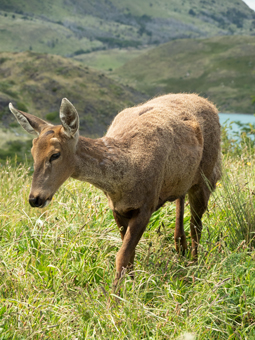
_0051.jpg)
When we arrived, we found that the female Puma had killed two Guanaco calves just minutes before, just seconds before the group reached her. The Puma was hunkered over one that was still alive, but clearly near death, while the other kill was about 50 yards away. After moving and playing with her kill, the Puma rose and walked to the other carcass, which she grabbed and, like a Leopard, crab-walked with the carcass between her forelegs as she dragged the kill back to the one she had abandoned. There, finally, she began to feed, where we left her as the evening light began to fade to darkness.
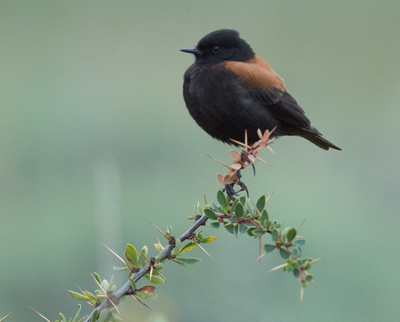
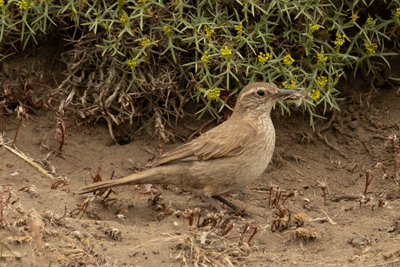
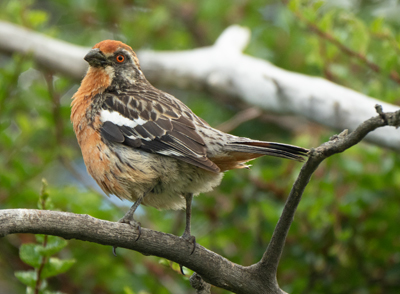
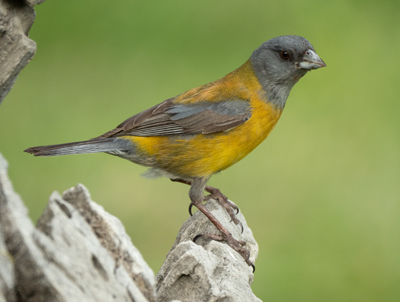
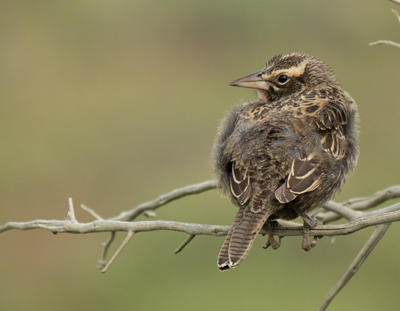
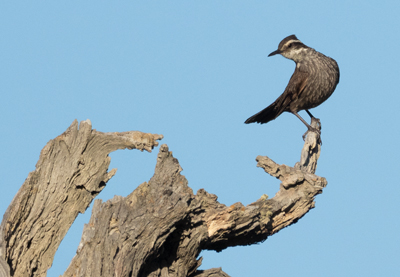
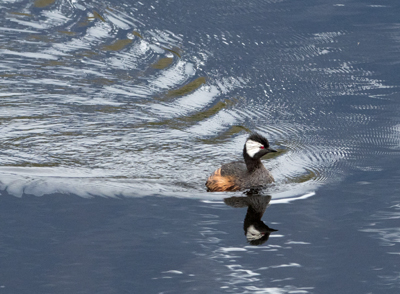
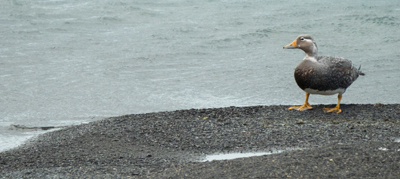
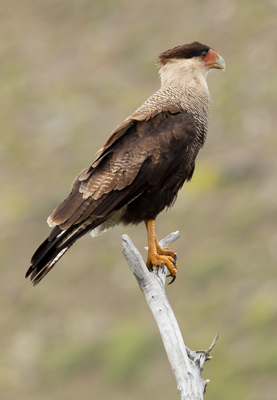
Row 1: Austral Negrito
Row 2: Scale-throated Earthcreeper
Row 3: Patagonian Sierra-Finch
Row 4: Long-tailed Meadowlark
Row 5: Dark-bellied Cinclodes
Row 6:White-tufted Grebe
Row 7: Flying Steamer Duck
Row 8: Southern Crested Caracara
Our second day was even better, as we found the female, Sarmiento, with her three cubs as they crossed the moors and headed to Lake Sarmiento. We followed her as she and her cubs walked along the coral-like rock formations, finally coming to rest beneath a ledge where they rested. From there our group, and several others, had incredible opportunities, until the cats, near noon, retreated into caves to spend the day.
We returned that evening and had another great session, with the family walking along the shoreline as they headed out for their evening’s hunt. After nearly a half-mile of paralleling the cats we left them, as they headed into the rolling hills.
Our day in the Park was especially productive, with much better weather than what we had on the first tour. Giant Grebes, Austral Parakeets, Ringed Kingfishers, and fantastic landscapes marked the day.
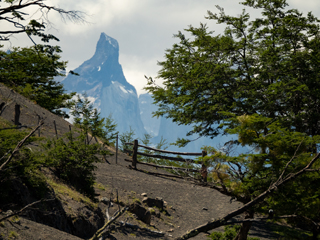
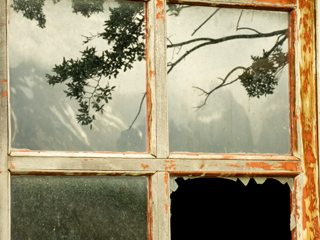
Day Three – a non-permit day
Not having a permit for the private ranch today, we planned on photographing the ‘filler species’ and scenes, beginning with a sunrise shoot of the Towers. The weather obliged, with a clear sky, and we had just reached our spot when we had a radio call that a Puma and cubs had been spotted in the Park. We scrapped the sunrise and raced towards the Pumas.
When we arrived, the three, a mother with two nearly full-grown cubs we had not seen earlier, were angling towards the road. In the distance a herd of Guanaco grazed, and the Puma mother suddenly stopped, accessed the situation, and, reminding me very much of a Cheetah, began a purposeful, head-up, walk-trot that eventually morphed into a bounding run that covered several hundred yards, disappearing behind a hill, in the direction of the road. We jumped in our vehicles and raced off.
I was the last vehicle of our three and had the leisure of knowing whether Mary or our guide saw the cats, so I was watching and saw her, with a kill, close to the road, that she had begun carrying off. We all stopped, or backed up first, and started shooting, and within a minute or so the two large cubs bounded down to join her, where she waited in high grass, chirping a contact call.
We thought the show was over, except for more shots of the three feeding, when our guide noticed another Guanaco calf sitting motionless on the hillside, only forty yards or so from the feeding cats. Several times the cats would pause from feeding and look about, and inevitably, finally, one of the cubs saw the calf. It charged, unexpectedly, and Mary saw it. We missed that first encounter but the Guanaco ran down the hill with all three cats in pursuit, towards us, and into great light. They quickly brought it down. Watch the video.
Again, we thought all was finished but after a few minutes the mother, who had made what looked like a killing choke-hold, let go. The baby staggered up and began to run, and the cubs took chase. What followed was an unparalleled training day, as the cubs tried tripping, climbing on, and simply chasing the calf, while the mother occasionally joined in, grabbing the calf and, with a neck hold, jerking it to the ground. This happened several times, with what we thought was the last resulting in a long chase, cubs in pursuit, before the female charged in and hammered the calf, then dragged it back towards the first kill.
All was over, we thought, but the calf wasn’t dead, and over the next many minutes struggled mightily, while fur was plucked and the three began to eat. In one of the struggles, the female finally did a killing bite, and the calf was still. The three ate, and finally, one by one, walked off, with one returning, to cover the kill with grasses – the first time we’d seen a Puma cover a kill.
It was a spectacular show, and somehow I kept the discipline to only shoot video, while Mary did stills and they were spectacular. Although I envied her shot, getting dual coverage was ideal.
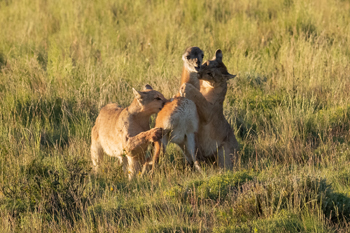
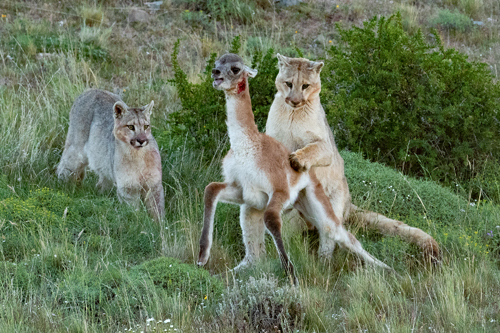
The tour wasn't all about Pumas. Just as we had on the first Tour, on the second we had wonderful luck with Guanacos- fighting, running, mating, babies, a variety of birds, and even several skunks. Here's a sample:
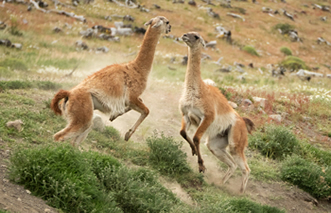
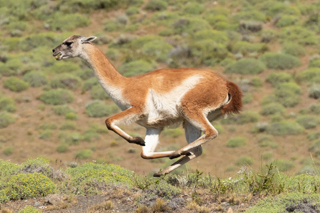
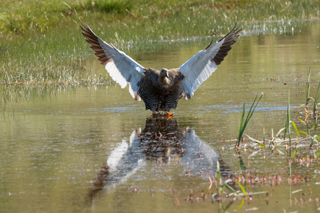
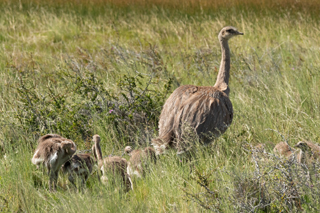
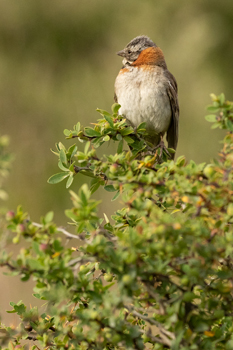
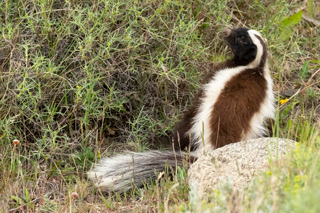
Row 1: Guanacos play fighting and running
Row 2: Upland Goose; Lesser Rhea
Row 3: Chestnut-collared Sparrow; Hognose Skunk




 Duck_1325.jpg)
Top Row: Ashy-headed Goose
Row 2: Black-necked Swan
Row 3: Chloe Wigeon
Row 4: Andean (Ruddy) Duck
On another morning, in the predawn and with no reports of Pumas, we stopped for a coffee break and snack while we waited for some word from one of the scouts. While we stood there talking, I looked up and across the road I saw Blinka, the most habituated of all the Pumas, just sitting there watching us. She crossed the road, and eventually worked her way down to the lake where we followed her along the shoreline. A couple of times, as the group kept parallel with the Puma from a higher ledge, the group lost sight of her. I was hanging back, not too worried about more walking Puma shots, and discovered that she sometimes doubled-back, watching from an unseen position as photographers filed by. Once, I was quite far behind our group when they lost sight of the Puma. I was moseying along, looking for fossils in the sedimentary rock and attempting to photograph some songbirds when I caught sight of the Puma as it slunk between the rocks, doubling back once more. I followed, and eventually she settled quite close to a trail, where we photographed her again before leaving her for a rest.
In the evening we returned, and Blinka began hunting. We followed her from the shores of the lake as she moved uphill. At one point she stopped and hunkered down, obviously in hunting mode. We couldn’t see what she may have seen from her angle, but she began carefully moving uphill where, eventually an adult Guanaco appeared above the ridge. The Guanaco walked passed, with Blinka slinking and hunkered, but her prey was too far away for a charge. She watched, and we waited. Another Guanaco appeared, and started down towards Blinka, but the first Guanaco moved downhill, towards us, where the wind carried the Puma’s scent and alerted the prey. The hunt was over, but it was a very tense hour! The first scenes of the video show this exciting time.
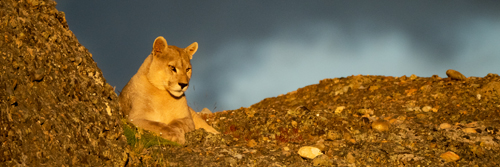
On our last afternoon we had a somewhat shy male, but in the last hours, with sweet, golden light, the Puma posed, framed by an iron-gray sky. It was a great pose and a great ending to a wonderful shoot.
Why you should travel with us
Testimonials
Join us on Facebook at: Follow Hoot Hollow
Office Phone: (717) 543-6423
Or FAX us at: (717) 543-5342
Mary and Joe are proud to endorse the Photo Retailer that has
done the absolute most in supporting nature photography in all
its facets ---

Check out the Monthly Specials
from Hunt's
Check out these TPPA specials!

Blinka, one of the most habituated of our Pumas


Guanaco - the Puma's principle prey
Chile 2018
The Pumas of Torres Del Paine – The Wildlife Tour
TRIP REPORT
Although we may work harder and are far more physical on this trip than any other, this Photo Tour is one of our all-time favorites. Nowhere else in the world can one be on foot, close, to a Big Cat, at least by still doing it safely. Mary and I have been visiting this area for over 15 years, on our own personal quest to photograph Pumas. After many years of dogged trying we were finally successful, and with our success we began Puma tours, in conjunction with our guide and outfitter, who was the pioneer in habituating Pumas. Although more people now visit and seek out Pumas than ever before – when we started, our group with our guide was the only one, and now Pumas are more accustomed to people than ever before, making the shooting much easier than it was when Mary and I started.
 Our two trips involved a total of 11 days in the field. On our first Photo Tour we had 27 Puma sightings, and on the second, I don’t really know, as I stopped worrying about numbers once we passed 20, and in total we had over 50 sightings, with perhaps 18 different Pumas, in an area less than fifty square miles – 10x5 miles at most.
Our two trips involved a total of 11 days in the field. On our first Photo Tour we had 27 Puma sightings, and on the second, I don’t really know, as I stopped worrying about numbers once we passed 20, and in total we had over 50 sightings, with perhaps 18 different Pumas, in an area less than fifty square miles – 10x5 miles at most.
In contrast to previous trip reports, the two that follow were written, mostly, at the conclusion of each tour. I simply didn’t have the time or energy to do more than download in the little free time we had. While this type of schedule might seem exhausting, and it is, no one complained, as the time afield was so incredibly productive.
For the first time, ever, Mary and I shot Olympus cameras exclusively. We brought some of our Canon gear as backup, or insurance, but never used the Canon gear. On our first three days I carried a 5D Mark IV and my favorite lens, the Tamron 150-600, in my pack, but didn’t use it. Finally, one afternoon as we waited for a Puma family to wake up and play I decided to try some high-speed video (119fps) with my 5D as the Pumas played. There was a stiff wind, and the camera and lens vibrated so badly that after only a few seconds I switched back to the Olympus. The Zuiko 300mm I was using was far smaller, and solid, and with 6 stops of built-in stabilization, I shot steady video, while Mary enjoyed the same as she shot stills.
This was the defining test for us, whether we’d be switching to Olympus gear or not, and Olympus passed our test. In another post – probably a Question of the Month – I’ll explain all of the reasons why. In the meantime, here’s the trip report, mostly illustrated with Mary’s photos.




Check out my first of several video from the trip –
Training Day – Young Pumas learn to hunt.
Here's the Reports:
Our first tour has ended, and only now do I have any time to recount a Trip Report  --- the days were that full, and exhausting. Our days began with a departure from our lodge at 4:45AM, a return sometime after noon, and another game drive in the afternoon that began around 5PM and continued beyond 9PM, and sometimes closer to 10PM. With a late meal, shower, and repacking for the following day, it was rare that we were in bed before 11PM, and sometimes much later.
--- the days were that full, and exhausting. Our days began with a departure from our lodge at 4:45AM, a return sometime after noon, and another game drive in the afternoon that began around 5PM and continued beyond 9PM, and sometimes closer to 10PM. With a late meal, shower, and repacking for the following day, it was rare that we were in bed before 11PM, and sometimes much later.
That’s less than four hours sleep a night, buttressed most days with some type of nap after lunch, which for the lucky ones who could sleep might add another two hours or so. Sound’s like fun, right?
Well, considering that we had 14 different Pumas, and 27 encounters in total, it was all worth it. Without question, it was the most productive trip we’ve ever had for Pumas, as well as for Patagonian Gray Fox, and the usual good shooting for Guanacos, Condors, and other species.
Our first game drive set the tone, and raised the bar so high that my friend and in-country guide worried that we may have created a false impression as to really how difficult it can be to have a good Puma encounter. After driving from Punta Arenas, meeting our guide in Puerto Natales and transferring our luggage to our vehicles, we continued on to our lodge, unpacked, and after a short break headed into the field.
Our spotter was already out there, positioned at a location where he could scan a large area. When we arrived, our group began a leisurely walk towards his position, but that calmness soon changed when our spotter radioed us, informing us that he had two Pumas in sight! The walk was now fast, with everyone who had not been with us previously (all but one) walking as fast as they could towards the spotter.
When they arrived, a Puma was walking away, and our guide was calling everyone to join him for a better angle, while most just stopped and started shooting, excited at seeing their first Puma in the wild, and of getting an insurance shot. Things were about to change.



_060652.jpg)
_060671.jpg)
_060690.jpg)
After posing on a ridgeline, one of two females walked pass us where she was eventually joined by her sister and the male Puma. The female was in heat, but the male wasn't ready, and despite numerous presentations never attempted to mate.
We soon learned that there was another Puma in view, walking towards the first. Then, we found that a THIRD Puma was watching us from a distant hill. Our Guide and spotter knew the female Pumas, and also knew that they were approachable, and so we advanced, slowly and carefully, but we were amply rewarded.
Six days after that encounter and I still can vividly remember the key events. Our first great shoot had the Puma lying atop a high cliff ledge, where we framed her against the loaf of bread shaped cliff faces, before she walked down, and sat, on another cliff with a backdrop of the emerald-colored lake. Later, this ‘first’ Puma walked straight towards us, only cutting to the right when it was nearly frame-filling, and then passing by only 40 or less yards away.
She was then joined by her sister, and then the male, which we first spotted far away on a hilltop. A female was in heat and ready to mate, and presented herself several times, but the male seemed unsure, and except for swatting at her, and doing the flehmen behavior, he did nothing but follow her. Still, watching this semi-courting, with the female sometimes chirping her call close to us, was exciting, and an incredible bar that we set for the remainder of the trip.

One of the females chirps, quite bird-like, in a contact call to her sister.
_060415.jpg)
But our Puma sightings only got more exciting. On a following morning we had a strange female Puma with two cubs – strange, because the cat has been seen for several weeks, sporting a weird, crippled, injured-looking gait that, when I saw it, I thought she was on death’s door and would have to be near death. Apparently, somehow, the Puma is surviving, perhaps aided by her nearly full-grown cubs that might be making the kills, or perhaps she’s scavenging and sharing kills with a daughter from a previous litter.
That afternoon, we found, for the first time, the mother Puma Sarmiento, who has three nearly full-grown cubs. The family were sleeping when we arrived, but after a 1.5 hour wait the cats woke up, and played and performed in the open grasslands below us. It was a stellar performance.

In the video you'll see how fast that Puma attack was. After knocking the guanaco calf down, the male Puma let it stand, and then chased it, sometimes tackling the calf, sometimes just half-heartedly swatting it, and eventually allowing the lucky calf to escape, where it joined its mother and the herd.
The following morning, Mary, our Guide, and my own field experience really came into play. We saw a group of Guanacos facing in one direction, whistling their alarm calls and slowly advancing, tentative, but obviously focused. We assumed a Puma was hiding, and probably had a kill. Mary then spotted what we thought was the kill, but turned out to be a live Guanaco baby that the Puma had slightly injured. We soon spotted the Puma, still playing with another baby it had captured. When our first baby Guanaco stood up, the Puma charged, but only grabbed at it, and then, as the baby ran off, the Puma took chase, sometimes knocking it down, and mostly just giving the baby a half-hearted swipe. Eventually they went over a ridge and we followed, to find that the baby Guanaco finally broke free and joined its mother, safe at last.

Other memorable moments included watching the same family of Pumas run down a hill after a Guanaco, then drink at a small stream before leaping across, directly towards many of our cameras. On another day, the same family walked by a lake, ducks in the background, and passed close by. We spent an afternoon waiting for a family of Pumas to wake up, hoping that they would begin to play before moving off to hunt. We were betting they'd do just that, utilizing an incredible theatre of open grass, and they did. The shooting was incredible.







Our last day with Pumas began with a sighting of the family, and and concluded with a sighting of Blinka, the female with one bad eye. Two years ago I photographed the same Puma when she was just a cub, and she is tame. The Puma came within walking distance of the road, but settled in brush, and offered no shots, and we left her to sleep through the day.
In the afternoon, however, we returned, and followed the cat as she walked up hill, at one time walking right to me, passing within a few feet before pausing on the same ridge where I was standing, looking back at me from just a few yards. I was using too large a lens, and dropped by pack, slowly, to dig out a wide-angle. I got the camera up in time, but had the camera set on video, and as I tried snapping a shot nothing happened. By the time, seconds only, that I made the setting change, the Puma walked off – leaving me with an almost indelible image, in my mind, of the Puma on the ridge, looking over the Patagonian landscape in the late afternoon, with sharp shadows defining each hilltop and glacial erratic boulder lying before her.
We continued following her, until she stopped, as Guanacos were in the distance. For nearly an hour we watched, hopefully, as one of the Guanacos slowly walked closer, but never approached close enough for the Puma to try a hunt. During this time, the Puma was hidden from view, but just as we were about to leave the Puma stood, and walked towards us, settling by a rock. We approached, and finished a fantastic week of Puma shooting with our closest encounter yet, with the tamest of all the Pumas in the area, completely unfazed by our quiet, careful, and respectful presence. The light was failing, and the wind was kicking up in blasts, and we headed back towards our vehicles. I was last, and paused several times to look back, and say a word of thanks to Blinka, and, honestly, half-expecting her to get up and follow us. She didn’t, but watched us leave, her gaze never leaving our group as we finally disappeared from her sight.





We had more fox dens than ever before, most of which we discovered on our tours.
Pumas were the focus of the trip, but we had incredible luck with Patagonian Gray Foxes, too. We found four different dens, with one providing a real drama. Mary and I were following our Guide’s vehicle, several hundred yards behind, when three small animals, yelping and screeching, suddenly rushed out on to the road right in front of me. Luckily, I didn’t hit any, and only after passing did I register what we had seen – three pup Foxes.

Mom Fox had, apparently, been trying to lead her pups to a new den (the old was on a bank right at one of the turn-offs). The mom Fox, a Vixen, would repeatedly run across the road, jump a small stream, turn around, jump the stream again, and either return to her pups or lie on the grass, or on the road, trying to get the pups to follow. At one point, the Vixen tried picking one up, but the pups were now too big and she couldn’t get a grip. Several times, we had to stop vehicles from speeding by, potentially smashing a pup or the Vixen as one or another would enter the road. Finally, the pups got tired and went back into the den, while the Vixen continued on to her new den, we think, perhaps to attend to pups that had already followed her. By the evening’s game drive the den was vacant … some time during our absence she successfully moved her family.
At another den we had first three pups, then five, appear on a back road. Shooting from the opposite bank, we watched as the pups came up to the bank of the road and played, with one pup repeatedly humping one of his nest mates. The entire show was precious.
At another den, high on a hill, we hiked up to check, but the pups disappeared. The Vixen wasn’t shy, and trotted by us, and found a nest of Southern Lapwings. The Fox would grab an egg, and run off, burying the egg before returning for another egg and doing the same. For the last egg, she stopped and ate it, while, all-the-while, the Lapwing pair dive-bombed and swooped at the invader.
Our final den provided an entirely different perspective, looking up at a rocky, cliff-side den where the dog Fox stood guard while the pups ran by, sometimes nuzzling their father.






Top: Correndera Pipit, Black-chested Buzzard Eagle;
Second row: Mourning Sierra-Finch
Third Row: The Towers, Great Grebe
Bottom: Black-necked Swan
We had several passes with Andean Condors, sometimes with birds flying fairly low but often arriving so unexpectedly that we missed the closest passes. I found two large flocks perched – one after I climbed a hill where I’d seen Condors dropping, as if to land. That group immediately flew off. Another group, much closer to the road, were shootable, as we stayed in the vehicle and shot from the windows, getting decent images of a male with a full-fledged crest.
Guanacos were giving birth, but the peak seemed a week earlier, and we found several trashcan-sized placentas, which oddly enough I’ve never seen any animal scavenge. We saw young Guanacos, but no births, and on our last morning we were treated to some nice play activity.


Infrared forest; Chloe Wigeon
One day we scheduled a day into the park, hoping to find Magallenic Woodpeckers, Huemuls, and Ringed Kingfishers. The Huemul is an endangered species of deer which is beginning to increase in numbers in the park, and at one location there is a very tame doe. We found her, and at times the issue was keeping far enough away for a shot, as the deer repeatedly walked up close. The Huemul doe now has what appears to be antler buds, and I’m wondering if the female, now 7 years old, may be losing her female hormones and manifesting testosterone symptoms, which might promote antler growth. In the US, Whitetail Deer does occasionally have horns, so the phenomenon isn’t unknown.
 We did not find the Woodpecker, but did have a brief shooting session with South America’s largest Kingfisher, the Ringed. At that location we also had families of Ashy-headed Geese, a species we find, but infrequently, in the Falklands.
We did not find the Woodpecker, but did have a brief shooting session with South America’s largest Kingfisher, the Ringed. At that location we also had families of Ashy-headed Geese, a species we find, but infrequently, in the Falklands.
The weather was as variable as one expects in Torres del Paine, although we only had one morning with real rain, but by late morning that storm had blown through and we had sunny weather as we photographed Pumas. Wind was a constant, and sometimes, as we waited for Pumas to perform, conditions were brutal, but we also had periods of calm, and sunny weather that made afternoons down-right hot.
As I write this we just had dinner with our next group, and in surveying their desires, all but one had no goal except to photograph Puma. This we should do, with luck, but I stressed that after 9 or 10AM Puma activity teases, most days, and doesn’t resume until 6 or7PM. During the non-Puma hours we’ll be photographing everything, rounding out the incredible Torres experience. Earlier in the day, as rode our transit vehicle towards Punta Arenas, Mary and I slept the entire three hours – truly exhausted from a truly rewarding week. Now, we’re ready for the next one!


Top: Hand-held flower field at 1/20th sec.
Bottom: Culpeo, or Andean Red Fox
Trip 2
 On our second trip I once again had little time to write a daily account, but even five days after our last time in the field the memories are fresh. Coming off of a great week of shooting, with incredible luck, I couldn’t imagine matching, or topping, the experiences we had on the first photo tour. We were so wrong.
On our second trip I once again had little time to write a daily account, but even five days after our last time in the field the memories are fresh. Coming off of a great week of shooting, with incredible luck, I couldn’t imagine matching, or topping, the experiences we had on the first photo tour. We were so wrong.
I must confess that I did not expect to have any luck on our first afternoon, despite the excitement and enthusiasm the five new-comers lent to the expedition. We cruised the Park road, scanning distant cliffs that were off-limits anyway, but hoping to at least spot a Puma to show the group. Mary was riding with me and noticed two distant human figures, and soon afterwards she spotted a Puma along an accessible Park trail. We parked, and our group headed downhill, where we found a male Puma and a female Puma nearby. The shooting was good for first-timers, but eventually the cats moved off, paralleling our trail and allowing us to attempt to keep up. Mary and I were still very, very tired from our first week of trekking, and trailing far behind our guide and spotter, we questioned whether or not we wanted to follow a Puma for ‘just more’ walking shots. Mary headed back to the vehicles to rest her back, and I continued with one of our other participants.
I didn’t give the encounter much hope, and when the others passed over a hill and out of sight I almost quit. Instead, I continued to a low rise where I could see the group, and our guide, waving wildly for another participant and I to continue. My radio’s volume was low, and all I heard was ‘babies.’ Check out the video.

_0051.jpg)
When we arrived, we found that the female Puma had killed two Guanaco calves just minutes before, just seconds before the group reached her. The Puma was hunkered over one that was still alive, but clearly near death, while the other kill was about 50 yards away. After moving and playing with her kill, the Puma rose and walked to the other carcass, which she grabbed and, like a Leopard, crab-walked with the carcass between her forelegs as she dragged the kill back to the one she had abandoned. There, finally, she began to feed, where we left her as the evening light began to fade to darkness.









Row 1: Austral Negrito
Row 2: Scale-throated Earthcreeper
Row 3: Patagonian Sierra-Finch
Row 4: Long-tailed Meadowlark
Row 5: Dark-bellied Cinclodes
Row 6:White-tufted Grebe
Row 7: Flying Steamer Duck
Row 8: Southern Crested Caracara
Our second day was even better, as we found the female, Sarmiento, with her three cubs as they crossed the moors and headed to Lake Sarmiento. We followed her as she and her cubs walked along the coral-like rock formations, finally coming to rest beneath a ledge where they rested. From there our group, and several others, had incredible opportunities, until the cats, near noon, retreated into caves to spend the day.
We returned that evening and had another great session, with the family walking along the shoreline as they headed out for their evening’s hunt. After nearly a half-mile of paralleling the cats we left them, as they headed into the rolling hills.
Our day in the Park was especially productive, with much better weather than what we had on the first tour. Giant Grebes, Austral Parakeets, Ringed Kingfishers, and fantastic landscapes marked the day.


Day Three – a non-permit day
Not having a permit for the private ranch today, we planned on photographing the ‘filler species’ and scenes, beginning with a sunrise shoot of the Towers. The weather obliged, with a clear sky, and we had just reached our spot when we had a radio call that a Puma and cubs had been spotted in the Park. We scrapped the sunrise and raced towards the Pumas.
When we arrived, the three, a mother with two nearly full-grown cubs we had not seen earlier, were angling towards the road. In the distance a herd of Guanaco grazed, and the Puma mother suddenly stopped, accessed the situation, and, reminding me very much of a Cheetah, began a purposeful, head-up, walk-trot that eventually morphed into a bounding run that covered several hundred yards, disappearing behind a hill, in the direction of the road. We jumped in our vehicles and raced off.
I was the last vehicle of our three and had the leisure of knowing whether Mary or our guide saw the cats, so I was watching and saw her, with a kill, close to the road, that she had begun carrying off. We all stopped, or backed up first, and started shooting, and within a minute or so the two large cubs bounded down to join her, where she waited in high grass, chirping a contact call.
We thought the show was over, except for more shots of the three feeding, when our guide noticed another Guanaco calf sitting motionless on the hillside, only forty yards or so from the feeding cats. Several times the cats would pause from feeding and look about, and inevitably, finally, one of the cubs saw the calf. It charged, unexpectedly, and Mary saw it. We missed that first encounter but the Guanaco ran down the hill with all three cats in pursuit, towards us, and into great light. They quickly brought it down. Watch the video.
Again, we thought all was finished but after a few minutes the mother, who had made what looked like a killing choke-hold, let go. The baby staggered up and began to run, and the cubs took chase. What followed was an unparalleled training day, as the cubs tried tripping, climbing on, and simply chasing the calf, while the mother occasionally joined in, grabbing the calf and, with a neck hold, jerking it to the ground. This happened several times, with what we thought was the last resulting in a long chase, cubs in pursuit, before the female charged in and hammered the calf, then dragged it back towards the first kill.
All was over, we thought, but the calf wasn’t dead, and over the next many minutes struggled mightily, while fur was plucked and the three began to eat. In one of the struggles, the female finally did a killing bite, and the calf was still. The three ate, and finally, one by one, walked off, with one returning, to cover the kill with grasses – the first time we’d seen a Puma cover a kill.
It was a spectacular show, and somehow I kept the discipline to only shoot video, while Mary did stills and they were spectacular. Although I envied her shot, getting dual coverage was ideal.


The tour wasn't all about Pumas. Just as we had on the first Tour, on the second we had wonderful luck with Guanacos- fighting, running, mating, babies, a variety of birds, and even several skunks. Here's a sample:






Row 1: Guanacos play fighting and running
Row 2: Upland Goose; Lesser Rhea
Row 3: Chestnut-collared Sparrow; Hognose Skunk




 Duck_1325.jpg)
Top Row: Ashy-headed Goose
Row 2: Black-necked Swan
Row 3: Chloe Wigeon
Row 4: Andean (Ruddy) Duck
On another morning, in the predawn and with no reports of Pumas, we stopped for a coffee break and snack while we waited for some word from one of the scouts. While we stood there talking, I looked up and across the road I saw Blinka, the most habituated of all the Pumas, just sitting there watching us. She crossed the road, and eventually worked her way down to the lake where we followed her along the shoreline. A couple of times, as the group kept parallel with the Puma from a higher ledge, the group lost sight of her. I was hanging back, not too worried about more walking Puma shots, and discovered that she sometimes doubled-back, watching from an unseen position as photographers filed by. Once, I was quite far behind our group when they lost sight of the Puma. I was moseying along, looking for fossils in the sedimentary rock and attempting to photograph some songbirds when I caught sight of the Puma as it slunk between the rocks, doubling back once more. I followed, and eventually she settled quite close to a trail, where we photographed her again before leaving her for a rest.
In the evening we returned, and Blinka began hunting. We followed her from the shores of the lake as she moved uphill. At one point she stopped and hunkered down, obviously in hunting mode. We couldn’t see what she may have seen from her angle, but she began carefully moving uphill where, eventually an adult Guanaco appeared above the ridge. The Guanaco walked passed, with Blinka slinking and hunkered, but her prey was too far away for a charge. She watched, and we waited. Another Guanaco appeared, and started down towards Blinka, but the first Guanaco moved downhill, towards us, where the wind carried the Puma’s scent and alerted the prey. The hunt was over, but it was a very tense hour! The first scenes of the video show this exciting time.

On our last afternoon we had a somewhat shy male, but in the last hours, with sweet, golden light, the Puma posed, framed by an iron-gray sky. It was a great pose and a great ending to a wonderful shoot.
Why you should travel with us
Testimonials
Join us on Facebook at: Follow Hoot Hollow
Office Phone: (717) 543-6423
Or FAX us at: (717) 543-5342
Mary and Joe are proud to endorse the Photo Retailer that has
done the absolute most in supporting nature photography in all
its facets ---

Check out the Monthly Specials
from Hunt's
Check out these TPPA specials!

Blinka, one of the most habituated of our Pumas


Guanaco - the Puma's principle prey
Chile 2018
The Pumas of Torres Del Paine – The Wildlife Tour
TRIP REPORT
Although we may work harder and are far more physical on this trip than any other, this Photo Tour is one of our all-time favorites. Nowhere else in the world can one be on foot, close, to a Big Cat, at least by still doing it safely. Mary and I have been visiting this area for over 15 years, on our own personal quest to photograph Pumas. After many years of dogged trying we were finally successful, and with our success we began Puma tours, in conjunction with our guide and outfitter, who was the pioneer in habituating Pumas. Although more people now visit and seek out Pumas than ever before – when we started, our group with our guide was the only one, and now Pumas are more accustomed to people than ever before, making the shooting much easier than it was when Mary and I started.
 Our two trips involved a total of 11 days in the field. On our first Photo Tour we had 27 Puma sightings, and on the second, I don’t really know, as I stopped worrying about numbers once we passed 20, and in total we had over 50 sightings, with perhaps 18 different Pumas, in an area less than fifty square miles – 10x5 miles at most.
Our two trips involved a total of 11 days in the field. On our first Photo Tour we had 27 Puma sightings, and on the second, I don’t really know, as I stopped worrying about numbers once we passed 20, and in total we had over 50 sightings, with perhaps 18 different Pumas, in an area less than fifty square miles – 10x5 miles at most.
In contrast to previous trip reports, the two that follow were written, mostly, at the conclusion of each tour. I simply didn’t have the time or energy to do more than download in the little free time we had. While this type of schedule might seem exhausting, and it is, no one complained, as the time afield was so incredibly productive.
For the first time, ever, Mary and I shot Olympus cameras exclusively. We brought some of our Canon gear as backup, or insurance, but never used the Canon gear. On our first three days I carried a 5D Mark IV and my favorite lens, the Tamron 150-600, in my pack, but didn’t use it. Finally, one afternoon as we waited for a Puma family to wake up and play I decided to try some high-speed video (119fps) with my 5D as the Pumas played. There was a stiff wind, and the camera and lens vibrated so badly that after only a few seconds I switched back to the Olympus. The Zuiko 300mm I was using was far smaller, and solid, and with 6 stops of built-in stabilization, I shot steady video, while Mary enjoyed the same as she shot stills.
This was the defining test for us, whether we’d be switching to Olympus gear or not, and Olympus passed our test. In another post – probably a Question of the Month – I’ll explain all of the reasons why. In the meantime, here’s the trip report, mostly illustrated with Mary’s photos.




Check out my first of several video from the trip –
Training Day – Young Pumas learn to hunt.
Here's the Reports:
Our first tour has ended, and only now do I have any time to recount a Trip Report  --- the days were that full, and exhausting. Our days began with a departure from our lodge at 4:45AM, a return sometime after noon, and another game drive in the afternoon that began around 5PM and continued beyond 9PM, and sometimes closer to 10PM. With a late meal, shower, and repacking for the following day, it was rare that we were in bed before 11PM, and sometimes much later.
--- the days were that full, and exhausting. Our days began with a departure from our lodge at 4:45AM, a return sometime after noon, and another game drive in the afternoon that began around 5PM and continued beyond 9PM, and sometimes closer to 10PM. With a late meal, shower, and repacking for the following day, it was rare that we were in bed before 11PM, and sometimes much later.
That’s less than four hours sleep a night, buttressed most days with some type of nap after lunch, which for the lucky ones who could sleep might add another two hours or so. Sound’s like fun, right?
Well, considering that we had 14 different Pumas, and 27 encounters in total, it was all worth it. Without question, it was the most productive trip we’ve ever had for Pumas, as well as for Patagonian Gray Fox, and the usual good shooting for Guanacos, Condors, and other species.
Our first game drive set the tone, and raised the bar so high that my friend and in-country guide worried that we may have created a false impression as to really how difficult it can be to have a good Puma encounter. After driving from Punta Arenas, meeting our guide in Puerto Natales and transferring our luggage to our vehicles, we continued on to our lodge, unpacked, and after a short break headed into the field.
Our spotter was already out there, positioned at a location where he could scan a large area. When we arrived, our group began a leisurely walk towards his position, but that calmness soon changed when our spotter radioed us, informing us that he had two Pumas in sight! The walk was now fast, with everyone who had not been with us previously (all but one) walking as fast as they could towards the spotter.
When they arrived, a Puma was walking away, and our guide was calling everyone to join him for a better angle, while most just stopped and started shooting, excited at seeing their first Puma in the wild, and of getting an insurance shot. Things were about to change.



_060652.jpg)
_060671.jpg)
_060690.jpg)
After posing on a ridgeline, one of two females walked pass us where she was eventually joined by her sister and the male Puma. The female was in heat, but the male wasn't ready, and despite numerous presentations never attempted to mate.
We soon learned that there was another Puma in view, walking towards the first. Then, we found that a THIRD Puma was watching us from a distant hill. Our Guide and spotter knew the female Pumas, and also knew that they were approachable, and so we advanced, slowly and carefully, but we were amply rewarded.
Six days after that encounter and I still can vividly remember the key events. Our first great shoot had the Puma lying atop a high cliff ledge, where we framed her against the loaf of bread shaped cliff faces, before she walked down, and sat, on another cliff with a backdrop of the emerald-colored lake. Later, this ‘first’ Puma walked straight towards us, only cutting to the right when it was nearly frame-filling, and then passing by only 40 or less yards away.
She was then joined by her sister, and then the male, which we first spotted far away on a hilltop. A female was in heat and ready to mate, and presented herself several times, but the male seemed unsure, and except for swatting at her, and doing the flehmen behavior, he did nothing but follow her. Still, watching this semi-courting, with the female sometimes chirping her call close to us, was exciting, and an incredible bar that we set for the remainder of the trip.

One of the females chirps, quite bird-like, in a contact call to her sister.
_060415.jpg)
But our Puma sightings only got more exciting. On a following morning we had a strange female Puma with two cubs – strange, because the cat has been seen for several weeks, sporting a weird, crippled, injured-looking gait that, when I saw it, I thought she was on death’s door and would have to be near death. Apparently, somehow, the Puma is surviving, perhaps aided by her nearly full-grown cubs that might be making the kills, or perhaps she’s scavenging and sharing kills with a daughter from a previous litter.
That afternoon, we found, for the first time, the mother Puma Sarmiento, who has three nearly full-grown cubs. The family were sleeping when we arrived, but after a 1.5 hour wait the cats woke up, and played and performed in the open grasslands below us. It was a stellar performance.

In the video you'll see how fast that Puma attack was. After knocking the guanaco calf down, the male Puma let it stand, and then chased it, sometimes tackling the calf, sometimes just half-heartedly swatting it, and eventually allowing the lucky calf to escape, where it joined its mother and the herd.
The following morning, Mary, our Guide, and my own field experience really came into play. We saw a group of Guanacos facing in one direction, whistling their alarm calls and slowly advancing, tentative, but obviously focused. We assumed a Puma was hiding, and probably had a kill. Mary then spotted what we thought was the kill, but turned out to be a live Guanaco baby that the Puma had slightly injured. We soon spotted the Puma, still playing with another baby it had captured. When our first baby Guanaco stood up, the Puma charged, but only grabbed at it, and then, as the baby ran off, the Puma took chase, sometimes knocking it down, and mostly just giving the baby a half-hearted swipe. Eventually they went over a ridge and we followed, to find that the baby Guanaco finally broke free and joined its mother, safe at last.

Other memorable moments included watching the same family of Pumas run down a hill after a Guanaco, then drink at a small stream before leaping across, directly towards many of our cameras. On another day, the same family walked by a lake, ducks in the background, and passed close by. We spent an afternoon waiting for a family of Pumas to wake up, hoping that they would begin to play before moving off to hunt. We were betting they'd do just that, utilizing an incredible theatre of open grass, and they did. The shooting was incredible.







Our last day with Pumas began with a sighting of the family, and and concluded with a sighting of Blinka, the female with one bad eye. Two years ago I photographed the same Puma when she was just a cub, and she is tame. The Puma came within walking distance of the road, but settled in brush, and offered no shots, and we left her to sleep through the day.
In the afternoon, however, we returned, and followed the cat as she walked up hill, at one time walking right to me, passing within a few feet before pausing on the same ridge where I was standing, looking back at me from just a few yards. I was using too large a lens, and dropped by pack, slowly, to dig out a wide-angle. I got the camera up in time, but had the camera set on video, and as I tried snapping a shot nothing happened. By the time, seconds only, that I made the setting change, the Puma walked off – leaving me with an almost indelible image, in my mind, of the Puma on the ridge, looking over the Patagonian landscape in the late afternoon, with sharp shadows defining each hilltop and glacial erratic boulder lying before her.
We continued following her, until she stopped, as Guanacos were in the distance. For nearly an hour we watched, hopefully, as one of the Guanacos slowly walked closer, but never approached close enough for the Puma to try a hunt. During this time, the Puma was hidden from view, but just as we were about to leave the Puma stood, and walked towards us, settling by a rock. We approached, and finished a fantastic week of Puma shooting with our closest encounter yet, with the tamest of all the Pumas in the area, completely unfazed by our quiet, careful, and respectful presence. The light was failing, and the wind was kicking up in blasts, and we headed back towards our vehicles. I was last, and paused several times to look back, and say a word of thanks to Blinka, and, honestly, half-expecting her to get up and follow us. She didn’t, but watched us leave, her gaze never leaving our group as we finally disappeared from her sight.





We had more fox dens than ever before, most of which we discovered on our tours.
Pumas were the focus of the trip, but we had incredible luck with Patagonian Gray Foxes, too. We found four different dens, with one providing a real drama. Mary and I were following our Guide’s vehicle, several hundred yards behind, when three small animals, yelping and screeching, suddenly rushed out on to the road right in front of me. Luckily, I didn’t hit any, and only after passing did I register what we had seen – three pup Foxes.

Mom Fox had, apparently, been trying to lead her pups to a new den (the old was on a bank right at one of the turn-offs). The mom Fox, a Vixen, would repeatedly run across the road, jump a small stream, turn around, jump the stream again, and either return to her pups or lie on the grass, or on the road, trying to get the pups to follow. At one point, the Vixen tried picking one up, but the pups were now too big and she couldn’t get a grip. Several times, we had to stop vehicles from speeding by, potentially smashing a pup or the Vixen as one or another would enter the road. Finally, the pups got tired and went back into the den, while the Vixen continued on to her new den, we think, perhaps to attend to pups that had already followed her. By the evening’s game drive the den was vacant … some time during our absence she successfully moved her family.
At another den we had first three pups, then five, appear on a back road. Shooting from the opposite bank, we watched as the pups came up to the bank of the road and played, with one pup repeatedly humping one of his nest mates. The entire show was precious.
At another den, high on a hill, we hiked up to check, but the pups disappeared. The Vixen wasn’t shy, and trotted by us, and found a nest of Southern Lapwings. The Fox would grab an egg, and run off, burying the egg before returning for another egg and doing the same. For the last egg, she stopped and ate it, while, all-the-while, the Lapwing pair dive-bombed and swooped at the invader.
Our final den provided an entirely different perspective, looking up at a rocky, cliff-side den where the dog Fox stood guard while the pups ran by, sometimes nuzzling their father.






Top: Correndera Pipit, Black-chested Buzzard Eagle;
Second row: Mourning Sierra-Finch
Third Row: The Towers, Great Grebe
Bottom: Black-necked Swan
We had several passes with Andean Condors, sometimes with birds flying fairly low but often arriving so unexpectedly that we missed the closest passes. I found two large flocks perched – one after I climbed a hill where I’d seen Condors dropping, as if to land. That group immediately flew off. Another group, much closer to the road, were shootable, as we stayed in the vehicle and shot from the windows, getting decent images of a male with a full-fledged crest.
Guanacos were giving birth, but the peak seemed a week earlier, and we found several trashcan-sized placentas, which oddly enough I’ve never seen any animal scavenge. We saw young Guanacos, but no births, and on our last morning we were treated to some nice play activity.


Infrared forest; Chloe Wigeon
One day we scheduled a day into the park, hoping to find Magallenic Woodpeckers, Huemuls, and Ringed Kingfishers. The Huemul is an endangered species of deer which is beginning to increase in numbers in the park, and at one location there is a very tame doe. We found her, and at times the issue was keeping far enough away for a shot, as the deer repeatedly walked up close. The Huemul doe now has what appears to be antler buds, and I’m wondering if the female, now 7 years old, may be losing her female hormones and manifesting testosterone symptoms, which might promote antler growth. In the US, Whitetail Deer does occasionally have horns, so the phenomenon isn’t unknown.
 We did not find the Woodpecker, but did have a brief shooting session with South America’s largest Kingfisher, the Ringed. At that location we also had families of Ashy-headed Geese, a species we find, but infrequently, in the Falklands.
We did not find the Woodpecker, but did have a brief shooting session with South America’s largest Kingfisher, the Ringed. At that location we also had families of Ashy-headed Geese, a species we find, but infrequently, in the Falklands.
The weather was as variable as one expects in Torres del Paine, although we only had one morning with real rain, but by late morning that storm had blown through and we had sunny weather as we photographed Pumas. Wind was a constant, and sometimes, as we waited for Pumas to perform, conditions were brutal, but we also had periods of calm, and sunny weather that made afternoons down-right hot.
As I write this we just had dinner with our next group, and in surveying their desires, all but one had no goal except to photograph Puma. This we should do, with luck, but I stressed that after 9 or 10AM Puma activity teases, most days, and doesn’t resume until 6 or7PM. During the non-Puma hours we’ll be photographing everything, rounding out the incredible Torres experience. Earlier in the day, as rode our transit vehicle towards Punta Arenas, Mary and I slept the entire three hours – truly exhausted from a truly rewarding week. Now, we’re ready for the next one!


Top: Hand-held flower field at 1/20th sec.
Bottom: Culpeo, or Andean Red Fox
Trip 2
 On our second trip I once again had little time to write a daily account, but even five days after our last time in the field the memories are fresh. Coming off of a great week of shooting, with incredible luck, I couldn’t imagine matching, or topping, the experiences we had on the first photo tour. We were so wrong.
On our second trip I once again had little time to write a daily account, but even five days after our last time in the field the memories are fresh. Coming off of a great week of shooting, with incredible luck, I couldn’t imagine matching, or topping, the experiences we had on the first photo tour. We were so wrong.
I must confess that I did not expect to have any luck on our first afternoon, despite the excitement and enthusiasm the five new-comers lent to the expedition. We cruised the Park road, scanning distant cliffs that were off-limits anyway, but hoping to at least spot a Puma to show the group. Mary was riding with me and noticed two distant human figures, and soon afterwards she spotted a Puma along an accessible Park trail. We parked, and our group headed downhill, where we found a male Puma and a female Puma nearby. The shooting was good for first-timers, but eventually the cats moved off, paralleling our trail and allowing us to attempt to keep up. Mary and I were still very, very tired from our first week of trekking, and trailing far behind our guide and spotter, we questioned whether or not we wanted to follow a Puma for ‘just more’ walking shots. Mary headed back to the vehicles to rest her back, and I continued with one of our other participants.
I didn’t give the encounter much hope, and when the others passed over a hill and out of sight I almost quit. Instead, I continued to a low rise where I could see the group, and our guide, waving wildly for another participant and I to continue. My radio’s volume was low, and all I heard was ‘babies.’ Check out the video.

_0051.jpg)
When we arrived, we found that the female Puma had killed two Guanaco calves just minutes before, just seconds before the group reached her. The Puma was hunkered over one that was still alive, but clearly near death, while the other kill was about 50 yards away. After moving and playing with her kill, the Puma rose and walked to the other carcass, which she grabbed and, like a Leopard, crab-walked with the carcass between her forelegs as she dragged the kill back to the one she had abandoned. There, finally, she began to feed, where we left her as the evening light began to fade to darkness.









Row 1: Austral Negrito
Row 2: Scale-throated Earthcreeper
Row 3: Patagonian Sierra-Finch
Row 4: Long-tailed Meadowlark
Row 5: Dark-bellied Cinclodes
Row 6:White-tufted Grebe
Row 7: Flying Steamer Duck
Row 8: Southern Crested Caracara
Our second day was even better, as we found the female, Sarmiento, with her three cubs as they crossed the moors and headed to Lake Sarmiento. We followed her as she and her cubs walked along the coral-like rock formations, finally coming to rest beneath a ledge where they rested. From there our group, and several others, had incredible opportunities, until the cats, near noon, retreated into caves to spend the day.
We returned that evening and had another great session, with the family walking along the shoreline as they headed out for their evening’s hunt. After nearly a half-mile of paralleling the cats we left them, as they headed into the rolling hills.
Our day in the Park was especially productive, with much better weather than what we had on the first tour. Giant Grebes, Austral Parakeets, Ringed Kingfishers, and fantastic landscapes marked the day.


Day Three – a non-permit day
Not having a permit for the private ranch today, we planned on photographing the ‘filler species’ and scenes, beginning with a sunrise shoot of the Towers. The weather obliged, with a clear sky, and we had just reached our spot when we had a radio call that a Puma and cubs had been spotted in the Park. We scrapped the sunrise and raced towards the Pumas.
When we arrived, the three, a mother with two nearly full-grown cubs we had not seen earlier, were angling towards the road. In the distance a herd of Guanaco grazed, and the Puma mother suddenly stopped, accessed the situation, and, reminding me very much of a Cheetah, began a purposeful, head-up, walk-trot that eventually morphed into a bounding run that covered several hundred yards, disappearing behind a hill, in the direction of the road. We jumped in our vehicles and raced off.
I was the last vehicle of our three and had the leisure of knowing whether Mary or our guide saw the cats, so I was watching and saw her, with a kill, close to the road, that she had begun carrying off. We all stopped, or backed up first, and started shooting, and within a minute or so the two large cubs bounded down to join her, where she waited in high grass, chirping a contact call.
We thought the show was over, except for more shots of the three feeding, when our guide noticed another Guanaco calf sitting motionless on the hillside, only forty yards or so from the feeding cats. Several times the cats would pause from feeding and look about, and inevitably, finally, one of the cubs saw the calf. It charged, unexpectedly, and Mary saw it. We missed that first encounter but the Guanaco ran down the hill with all three cats in pursuit, towards us, and into great light. They quickly brought it down. Watch the video.
Again, we thought all was finished but after a few minutes the mother, who had made what looked like a killing choke-hold, let go. The baby staggered up and began to run, and the cubs took chase. What followed was an unparalleled training day, as the cubs tried tripping, climbing on, and simply chasing the calf, while the mother occasionally joined in, grabbing the calf and, with a neck hold, jerking it to the ground. This happened several times, with what we thought was the last resulting in a long chase, cubs in pursuit, before the female charged in and hammered the calf, then dragged it back towards the first kill.
All was over, we thought, but the calf wasn’t dead, and over the next many minutes struggled mightily, while fur was plucked and the three began to eat. In one of the struggles, the female finally did a killing bite, and the calf was still. The three ate, and finally, one by one, walked off, with one returning, to cover the kill with grasses – the first time we’d seen a Puma cover a kill.
It was a spectacular show, and somehow I kept the discipline to only shoot video, while Mary did stills and they were spectacular. Although I envied her shot, getting dual coverage was ideal.


The tour wasn't all about Pumas. Just as we had on the first Tour, on the second we had wonderful luck with Guanacos- fighting, running, mating, babies, a variety of birds, and even several skunks. Here's a sample:






Row 1: Guanacos play fighting and running
Row 2: Upland Goose; Lesser Rhea
Row 3: Chestnut-collared Sparrow; Hognose Skunk




 Duck_1325.jpg)
Top Row: Ashy-headed Goose
Row 2: Black-necked Swan
Row 3: Chloe Wigeon
Row 4: Andean (Ruddy) Duck
On another morning, in the predawn and with no reports of Pumas, we stopped for a coffee break and snack while we waited for some word from one of the scouts. While we stood there talking, I looked up and across the road I saw Blinka, the most habituated of all the Pumas, just sitting there watching us. She crossed the road, and eventually worked her way down to the lake where we followed her along the shoreline. A couple of times, as the group kept parallel with the Puma from a higher ledge, the group lost sight of her. I was hanging back, not too worried about more walking Puma shots, and discovered that she sometimes doubled-back, watching from an unseen position as photographers filed by. Once, I was quite far behind our group when they lost sight of the Puma. I was moseying along, looking for fossils in the sedimentary rock and attempting to photograph some songbirds when I caught sight of the Puma as it slunk between the rocks, doubling back once more. I followed, and eventually she settled quite close to a trail, where we photographed her again before leaving her for a rest.
In the evening we returned, and Blinka began hunting. We followed her from the shores of the lake as she moved uphill. At one point she stopped and hunkered down, obviously in hunting mode. We couldn’t see what she may have seen from her angle, but she began carefully moving uphill where, eventually an adult Guanaco appeared above the ridge. The Guanaco walked passed, with Blinka slinking and hunkered, but her prey was too far away for a charge. She watched, and we waited. Another Guanaco appeared, and started down towards Blinka, but the first Guanaco moved downhill, towards us, where the wind carried the Puma’s scent and alerted the prey. The hunt was over, but it was a very tense hour! The first scenes of the video show this exciting time.

On our last afternoon we had a somewhat shy male, but in the last hours, with sweet, golden light, the Puma posed, framed by an iron-gray sky. It was a great pose and a great ending to a wonderful shoot.
Why you should travel with us
Testimonials
Join us on Facebook at: Follow Hoot Hollow
Office Phone: (717) 543-6423
Or FAX us at: (717) 543-5342
Mary and Joe are proud to endorse the Photo Retailer that has
done the absolute most in supporting nature photography in all
its facets ---

Check out the Monthly Specials
from Hunt's
Check out these TPPA specials!

Blinka, one of the most habituated of our Pumas


Guanaco - the Puma's principle prey
Chile 2018
The Pumas of Torres Del Paine – The Wildlife Tour
TRIP REPORT
Although we may work harder and are far more physical on this trip than any other, this Photo Tour is one of our all-time favorites. Nowhere else in the world can one be on foot, close, to a Big Cat, at least by still doing it safely. Mary and I have been visiting this area for over 15 years, on our own personal quest to photograph Pumas. After many years of dogged trying we were finally successful, and with our success we began Puma tours, in conjunction with our guide and outfitter, who was the pioneer in habituating Pumas. Although more people now visit and seek out Pumas than ever before – when we started, our group with our guide was the only one, and now Pumas are more accustomed to people than ever before, making the shooting much easier than it was when Mary and I started.
 Our two trips involved a total of 11 days in the field. On our first Photo Tour we had 27 Puma sightings, and on the second, I don’t really know, as I stopped worrying about numbers once we passed 20, and in total we had over 50 sightings, with perhaps 18 different Pumas, in an area less than fifty square miles – 10x5 miles at most.
Our two trips involved a total of 11 days in the field. On our first Photo Tour we had 27 Puma sightings, and on the second, I don’t really know, as I stopped worrying about numbers once we passed 20, and in total we had over 50 sightings, with perhaps 18 different Pumas, in an area less than fifty square miles – 10x5 miles at most.
In contrast to previous trip reports, the two that follow were written, mostly, at the conclusion of each tour. I simply didn’t have the time or energy to do more than download in the little free time we had. While this type of schedule might seem exhausting, and it is, no one complained, as the time afield was so incredibly productive.
For the first time, ever, Mary and I shot Olympus cameras exclusively. We brought some of our Canon gear as backup, or insurance, but never used the Canon gear. On our first three days I carried a 5D Mark IV and my favorite lens, the Tamron 150-600, in my pack, but didn’t use it. Finally, one afternoon as we waited for a Puma family to wake up and play I decided to try some high-speed video (119fps) with my 5D as the Pumas played. There was a stiff wind, and the camera and lens vibrated so badly that after only a few seconds I switched back to the Olympus. The Zuiko 300mm I was using was far smaller, and solid, and with 6 stops of built-in stabilization, I shot steady video, while Mary enjoyed the same as she shot stills.
This was the defining test for us, whether we’d be switching to Olympus gear or not, and Olympus passed our test. In another post – probably a Question of the Month – I’ll explain all of the reasons why. In the meantime, here’s the trip report, mostly illustrated with Mary’s photos.




Check out my first of several video from the trip –
Training Day – Young Pumas learn to hunt.
Here's the Reports:
Our first tour has ended, and only now do I have any time to recount a Trip Report  --- the days were that full, and exhausting. Our days began with a departure from our lodge at 4:45AM, a return sometime after noon, and another game drive in the afternoon that began around 5PM and continued beyond 9PM, and sometimes closer to 10PM. With a late meal, shower, and repacking for the following day, it was rare that we were in bed before 11PM, and sometimes much later.
--- the days were that full, and exhausting. Our days began with a departure from our lodge at 4:45AM, a return sometime after noon, and another game drive in the afternoon that began around 5PM and continued beyond 9PM, and sometimes closer to 10PM. With a late meal, shower, and repacking for the following day, it was rare that we were in bed before 11PM, and sometimes much later.
That’s less than four hours sleep a night, buttressed most days with some type of nap after lunch, which for the lucky ones who could sleep might add another two hours or so. Sound’s like fun, right?
Well, considering that we had 14 different Pumas, and 27 encounters in total, it was all worth it. Without question, it was the most productive trip we’ve ever had for Pumas, as well as for Patagonian Gray Fox, and the usual good shooting for Guanacos, Condors, and other species.
Our first game drive set the tone, and raised the bar so high that my friend and in-country guide worried that we may have created a false impression as to really how difficult it can be to have a good Puma encounter. After driving from Punta Arenas, meeting our guide in Puerto Natales and transferring our luggage to our vehicles, we continued on to our lodge, unpacked, and after a short break headed into the field.
Our spotter was already out there, positioned at a location where he could scan a large area. When we arrived, our group began a leisurely walk towards his position, but that calmness soon changed when our spotter radioed us, informing us that he had two Pumas in sight! The walk was now fast, with everyone who had not been with us previously (all but one) walking as fast as they could towards the spotter.
When they arrived, a Puma was walking away, and our guide was calling everyone to join him for a better angle, while most just stopped and started shooting, excited at seeing their first Puma in the wild, and of getting an insurance shot. Things were about to change.



_060652.jpg)
_060671.jpg)
_060690.jpg)
After posing on a ridgeline, one of two females walked pass us where she was eventually joined by her sister and the male Puma. The female was in heat, but the male wasn't ready, and despite numerous presentations never attempted to mate.
We soon learned that there was another Puma in view, walking towards the first. Then, we found that a THIRD Puma was watching us from a distant hill. Our Guide and spotter knew the female Pumas, and also knew that they were approachable, and so we advanced, slowly and carefully, but we were amply rewarded.
Six days after that encounter and I still can vividly remember the key events. Our first great shoot had the Puma lying atop a high cliff ledge, where we framed her against the loaf of bread shaped cliff faces, before she walked down, and sat, on another cliff with a backdrop of the emerald-colored lake. Later, this ‘first’ Puma walked straight towards us, only cutting to the right when it was nearly frame-filling, and then passing by only 40 or less yards away.
She was then joined by her sister, and then the male, which we first spotted far away on a hilltop. A female was in heat and ready to mate, and presented herself several times, but the male seemed unsure, and except for swatting at her, and doing the flehmen behavior, he did nothing but follow her. Still, watching this semi-courting, with the female sometimes chirping her call close to us, was exciting, and an incredible bar that we set for the remainder of the trip.

One of the females chirps, quite bird-like, in a contact call to her sister.
_060415.jpg)
But our Puma sightings only got more exciting. On a following morning we had a strange female Puma with two cubs – strange, because the cat has been seen for several weeks, sporting a weird, crippled, injured-looking gait that, when I saw it, I thought she was on death’s door and would have to be near death. Apparently, somehow, the Puma is surviving, perhaps aided by her nearly full-grown cubs that might be making the kills, or perhaps she’s scavenging and sharing kills with a daughter from a previous litter.
That afternoon, we found, for the first time, the mother Puma Sarmiento, who has three nearly full-grown cubs. The family were sleeping when we arrived, but after a 1.5 hour wait the cats woke up, and played and performed in the open grasslands below us. It was a stellar performance.

In the video you'll see how fast that Puma attack was. After knocking the guanaco calf down, the male Puma let it stand, and then chased it, sometimes tackling the calf, sometimes just half-heartedly swatting it, and eventually allowing the lucky calf to escape, where it joined its mother and the herd.
The following morning, Mary, our Guide, and my own field experience really came into play. We saw a group of Guanacos facing in one direction, whistling their alarm calls and slowly advancing, tentative, but obviously focused. We assumed a Puma was hiding, and probably had a kill. Mary then spotted what we thought was the kill, but turned out to be a live Guanaco baby that the Puma had slightly injured. We soon spotted the Puma, still playing with another baby it had captured. When our first baby Guanaco stood up, the Puma charged, but only grabbed at it, and then, as the baby ran off, the Puma took chase, sometimes knocking it down, and mostly just giving the baby a half-hearted swipe. Eventually they went over a ridge and we followed, to find that the baby Guanaco finally broke free and joined its mother, safe at last.

Other memorable moments included watching the same family of Pumas run down a hill after a Guanaco, then drink at a small stream before leaping across, directly towards many of our cameras. On another day, the same family walked by a lake, ducks in the background, and passed close by. We spent an afternoon waiting for a family of Pumas to wake up, hoping that they would begin to play before moving off to hunt. We were betting they'd do just that, utilizing an incredible theatre of open grass, and they did. The shooting was incredible.







Our last day with Pumas began with a sighting of the family, and and concluded with a sighting of Blinka, the female with one bad eye. Two years ago I photographed the same Puma when she was just a cub, and she is tame. The Puma came within walking distance of the road, but settled in brush, and offered no shots, and we left her to sleep through the day.
In the afternoon, however, we returned, and followed the cat as she walked up hill, at one time walking right to me, passing within a few feet before pausing on the same ridge where I was standing, looking back at me from just a few yards. I was using too large a lens, and dropped by pack, slowly, to dig out a wide-angle. I got the camera up in time, but had the camera set on video, and as I tried snapping a shot nothing happened. By the time, seconds only, that I made the setting change, the Puma walked off – leaving me with an almost indelible image, in my mind, of the Puma on the ridge, looking over the Patagonian landscape in the late afternoon, with sharp shadows defining each hilltop and glacial erratic boulder lying before her.
We continued following her, until she stopped, as Guanacos were in the distance. For nearly an hour we watched, hopefully, as one of the Guanacos slowly walked closer, but never approached close enough for the Puma to try a hunt. During this time, the Puma was hidden from view, but just as we were about to leave the Puma stood, and walked towards us, settling by a rock. We approached, and finished a fantastic week of Puma shooting with our closest encounter yet, with the tamest of all the Pumas in the area, completely unfazed by our quiet, careful, and respectful presence. The light was failing, and the wind was kicking up in blasts, and we headed back towards our vehicles. I was last, and paused several times to look back, and say a word of thanks to Blinka, and, honestly, half-expecting her to get up and follow us. She didn’t, but watched us leave, her gaze never leaving our group as we finally disappeared from her sight.





We had more fox dens than ever before, most of which we discovered on our tours.
Pumas were the focus of the trip, but we had incredible luck with Patagonian Gray Foxes, too. We found four different dens, with one providing a real drama. Mary and I were following our Guide’s vehicle, several hundred yards behind, when three small animals, yelping and screeching, suddenly rushed out on to the road right in front of me. Luckily, I didn’t hit any, and only after passing did I register what we had seen – three pup Foxes.

Mom Fox had, apparently, been trying to lead her pups to a new den (the old was on a bank right at one of the turn-offs). The mom Fox, a Vixen, would repeatedly run across the road, jump a small stream, turn around, jump the stream again, and either return to her pups or lie on the grass, or on the road, trying to get the pups to follow. At one point, the Vixen tried picking one up, but the pups were now too big and she couldn’t get a grip. Several times, we had to stop vehicles from speeding by, potentially smashing a pup or the Vixen as one or another would enter the road. Finally, the pups got tired and went back into the den, while the Vixen continued on to her new den, we think, perhaps to attend to pups that had already followed her. By the evening’s game drive the den was vacant … some time during our absence she successfully moved her family.
At another den we had first three pups, then five, appear on a back road. Shooting from the opposite bank, we watched as the pups came up to the bank of the road and played, with one pup repeatedly humping one of his nest mates. The entire show was precious.
At another den, high on a hill, we hiked up to check, but the pups disappeared. The Vixen wasn’t shy, and trotted by us, and found a nest of Southern Lapwings. The Fox would grab an egg, and run off, burying the egg before returning for another egg and doing the same. For the last egg, she stopped and ate it, while, all-the-while, the Lapwing pair dive-bombed and swooped at the invader.
Our final den provided an entirely different perspective, looking up at a rocky, cliff-side den where the dog Fox stood guard while the pups ran by, sometimes nuzzling their father.






Top: Correndera Pipit, Black-chested Buzzard Eagle;
Second row: Mourning Sierra-Finch
Third Row: The Towers, Great Grebe
Bottom: Black-necked Swan
We had several passes with Andean Condors, sometimes with birds flying fairly low but often arriving so unexpectedly that we missed the closest passes. I found two large flocks perched – one after I climbed a hill where I’d seen Condors dropping, as if to land. That group immediately flew off. Another group, much closer to the road, were shootable, as we stayed in the vehicle and shot from the windows, getting decent images of a male with a full-fledged crest.
Guanacos were giving birth, but the peak seemed a week earlier, and we found several trashcan-sized placentas, which oddly enough I’ve never seen any animal scavenge. We saw young Guanacos, but no births, and on our last morning we were treated to some nice play activity.


Infrared forest; Chloe Wigeon
One day we scheduled a day into the park, hoping to find Magallenic Woodpeckers, Huemuls, and Ringed Kingfishers. The Huemul is an endangered species of deer which is beginning to increase in numbers in the park, and at one location there is a very tame doe. We found her, and at times the issue was keeping far enough away for a shot, as the deer repeatedly walked up close. The Huemul doe now has what appears to be antler buds, and I’m wondering if the female, now 7 years old, may be losing her female hormones and manifesting testosterone symptoms, which might promote antler growth. In the US, Whitetail Deer does occasionally have horns, so the phenomenon isn’t unknown.
 We did not find the Woodpecker, but did have a brief shooting session with South America’s largest Kingfisher, the Ringed. At that location we also had families of Ashy-headed Geese, a species we find, but infrequently, in the Falklands.
We did not find the Woodpecker, but did have a brief shooting session with South America’s largest Kingfisher, the Ringed. At that location we also had families of Ashy-headed Geese, a species we find, but infrequently, in the Falklands.
The weather was as variable as one expects in Torres del Paine, although we only had one morning with real rain, but by late morning that storm had blown through and we had sunny weather as we photographed Pumas. Wind was a constant, and sometimes, as we waited for Pumas to perform, conditions were brutal, but we also had periods of calm, and sunny weather that made afternoons down-right hot.
As I write this we just had dinner with our next group, and in surveying their desires, all but one had no goal except to photograph Puma. This we should do, with luck, but I stressed that after 9 or 10AM Puma activity teases, most days, and doesn’t resume until 6 or7PM. During the non-Puma hours we’ll be photographing everything, rounding out the incredible Torres experience. Earlier in the day, as rode our transit vehicle towards Punta Arenas, Mary and I slept the entire three hours – truly exhausted from a truly rewarding week. Now, we’re ready for the next one!


Top: Hand-held flower field at 1/20th sec.
Bottom: Culpeo, or Andean Red Fox
Trip 2
 On our second trip I once again had little time to write a daily account, but even five days after our last time in the field the memories are fresh. Coming off of a great week of shooting, with incredible luck, I couldn’t imagine matching, or topping, the experiences we had on the first photo tour. We were so wrong.
On our second trip I once again had little time to write a daily account, but even five days after our last time in the field the memories are fresh. Coming off of a great week of shooting, with incredible luck, I couldn’t imagine matching, or topping, the experiences we had on the first photo tour. We were so wrong.
I must confess that I did not expect to have any luck on our first afternoon, despite the excitement and enthusiasm the five new-comers lent to the expedition. We cruised the Park road, scanning distant cliffs that were off-limits anyway, but hoping to at least spot a Puma to show the group. Mary was riding with me and noticed two distant human figures, and soon afterwards she spotted a Puma along an accessible Park trail. We parked, and our group headed downhill, where we found a male Puma and a female Puma nearby. The shooting was good for first-timers, but eventually the cats moved off, paralleling our trail and allowing us to attempt to keep up. Mary and I were still very, very tired from our first week of trekking, and trailing far behind our guide and spotter, we questioned whether or not we wanted to follow a Puma for ‘just more’ walking shots. Mary headed back to the vehicles to rest her back, and I continued with one of our other participants.
I didn’t give the encounter much hope, and when the others passed over a hill and out of sight I almost quit. Instead, I continued to a low rise where I could see the group, and our guide, waving wildly for another participant and I to continue. My radio’s volume was low, and all I heard was ‘babies.’ Check out the video.

_0051.jpg)
When we arrived, we found that the female Puma had killed two Guanaco calves just minutes before, just seconds before the group reached her. The Puma was hunkered over one that was still alive, but clearly near death, while the other kill was about 50 yards away. After moving and playing with her kill, the Puma rose and walked to the other carcass, which she grabbed and, like a Leopard, crab-walked with the carcass between her forelegs as she dragged the kill back to the one she had abandoned. There, finally, she began to feed, where we left her as the evening light began to fade to darkness.









Row 1: Austral Negrito
Row 2: Scale-throated Earthcreeper
Row 3: Patagonian Sierra-Finch
Row 4: Long-tailed Meadowlark
Row 5: Dark-bellied Cinclodes
Row 6:White-tufted Grebe
Row 7: Flying Steamer Duck
Row 8: Southern Crested Caracara
Our second day was even better, as we found the female, Sarmiento, with her three cubs as they crossed the moors and headed to Lake Sarmiento. We followed her as she and her cubs walked along the coral-like rock formations, finally coming to rest beneath a ledge where they rested. From there our group, and several others, had incredible opportunities, until the cats, near noon, retreated into caves to spend the day.
We returned that evening and had another great session, with the family walking along the shoreline as they headed out for their evening’s hunt. After nearly a half-mile of paralleling the cats we left them, as they headed into the rolling hills.
Our day in the Park was especially productive, with much better weather than what we had on the first tour. Giant Grebes, Austral Parakeets, Ringed Kingfishers, and fantastic landscapes marked the day.


Day Three – a non-permit day
Not having a permit for the private ranch today, we planned on photographing the ‘filler species’ and scenes, beginning with a sunrise shoot of the Towers. The weather obliged, with a clear sky, and we had just reached our spot when we had a radio call that a Puma and cubs had been spotted in the Park. We scrapped the sunrise and raced towards the Pumas.
When we arrived, the three, a mother with two nearly full-grown cubs we had not seen earlier, were angling towards the road. In the distance a herd of Guanaco grazed, and the Puma mother suddenly stopped, accessed the situation, and, reminding me very much of a Cheetah, began a purposeful, head-up, walk-trot that eventually morphed into a bounding run that covered several hundred yards, disappearing behind a hill, in the direction of the road. We jumped in our vehicles and raced off.
I was the last vehicle of our three and had the leisure of knowing whether Mary or our guide saw the cats, so I was watching and saw her, with a kill, close to the road, that she had begun carrying off. We all stopped, or backed up first, and started shooting, and within a minute or so the two large cubs bounded down to join her, where she waited in high grass, chirping a contact call.
We thought the show was over, except for more shots of the three feeding, when our guide noticed another Guanaco calf sitting motionless on the hillside, only forty yards or so from the feeding cats. Several times the cats would pause from feeding and look about, and inevitably, finally, one of the cubs saw the calf. It charged, unexpectedly, and Mary saw it. We missed that first encounter but the Guanaco ran down the hill with all three cats in pursuit, towards us, and into great light. They quickly brought it down. Watch the video.
Again, we thought all was finished but after a few minutes the mother, who had made what looked like a killing choke-hold, let go. The baby staggered up and began to run, and the cubs took chase. What followed was an unparalleled training day, as the cubs tried tripping, climbing on, and simply chasing the calf, while the mother occasionally joined in, grabbing the calf and, with a neck hold, jerking it to the ground. This happened several times, with what we thought was the last resulting in a long chase, cubs in pursuit, before the female charged in and hammered the calf, then dragged it back towards the first kill.
All was over, we thought, but the calf wasn’t dead, and over the next many minutes struggled mightily, while fur was plucked and the three began to eat. In one of the struggles, the female finally did a killing bite, and the calf was still. The three ate, and finally, one by one, walked off, with one returning, to cover the kill with grasses – the first time we’d seen a Puma cover a kill.
It was a spectacular show, and somehow I kept the discipline to only shoot video, while Mary did stills and they were spectacular. Although I envied her shot, getting dual coverage was ideal.


The tour wasn't all about Pumas. Just as we had on the first Tour, on the second we had wonderful luck with Guanacos- fighting, running, mating, babies, a variety of birds, and even several skunks. Here's a sample:






Row 1: Guanacos play fighting and running
Row 2: Upland Goose; Lesser Rhea
Row 3: Chestnut-collared Sparrow; Hognose Skunk




 Duck_1325.jpg)
Top Row: Ashy-headed Goose
Row 2: Black-necked Swan
Row 3: Chloe Wigeon
Row 4: Andean (Ruddy) Duck
On another morning, in the predawn and with no reports of Pumas, we stopped for a coffee break and snack while we waited for some word from one of the scouts. While we stood there talking, I looked up and across the road I saw Blinka, the most habituated of all the Pumas, just sitting there watching us. She crossed the road, and eventually worked her way down to the lake where we followed her along the shoreline. A couple of times, as the group kept parallel with the Puma from a higher ledge, the group lost sight of her. I was hanging back, not too worried about more walking Puma shots, and discovered that she sometimes doubled-back, watching from an unseen position as photographers filed by. Once, I was quite far behind our group when they lost sight of the Puma. I was moseying along, looking for fossils in the sedimentary rock and attempting to photograph some songbirds when I caught sight of the Puma as it slunk between the rocks, doubling back once more. I followed, and eventually she settled quite close to a trail, where we photographed her again before leaving her for a rest.
In the evening we returned, and Blinka began hunting. We followed her from the shores of the lake as she moved uphill. At one point she stopped and hunkered down, obviously in hunting mode. We couldn’t see what she may have seen from her angle, but she began carefully moving uphill where, eventually an adult Guanaco appeared above the ridge. The Guanaco walked passed, with Blinka slinking and hunkered, but her prey was too far away for a charge. She watched, and we waited. Another Guanaco appeared, and started down towards Blinka, but the first Guanaco moved downhill, towards us, where the wind carried the Puma’s scent and alerted the prey. The hunt was over, but it was a very tense hour! The first scenes of the video show this exciting time.

On our last afternoon we had a somewhat shy male, but in the last hours, with sweet, golden light, the Puma posed, framed by an iron-gray sky. It was a great pose and a great ending to a wonderful shoot.
Why you should travel with us
Testimonials
Join us on Facebook at: Follow Hoot Hollow
Office Phone: (717) 543-6423
Or FAX us at: (717) 543-5342
Mary and Joe are proud to endorse the Photo Retailer that has
done the absolute most in supporting nature photography in all
its facets ---

Check out the Monthly Specials
from Hunt's
Check out these TPPA specials!

Blinka, one of the most habituated of our Pumas


Guanaco - the Puma's principle prey
Chile 2018
The Pumas of Torres Del Paine – The Wildlife Tour
TRIP REPORT
Although we may work harder and are far more physical on this trip than any other, this Photo Tour is one of our all-time favorites. Nowhere else in the world can one be on foot, close, to a Big Cat, at least by still doing it safely. Mary and I have been visiting this area for over 15 years, on our own personal quest to photograph Pumas. After many years of dogged trying we were finally successful, and with our success we began Puma tours, in conjunction with our guide and outfitter, who was the pioneer in habituating Pumas. Although more people now visit and seek out Pumas than ever before – when we started, our group with our guide was the only one, and now Pumas are more accustomed to people than ever before, making the shooting much easier than it was when Mary and I started.
 Our two trips involved a total of 11 days in the field. On our first Photo Tour we had 27 Puma sightings, and on the second, I don’t really know, as I stopped worrying about numbers once we passed 20, and in total we had over 50 sightings, with perhaps 18 different Pumas, in an area less than fifty square miles – 10x5 miles at most.
Our two trips involved a total of 11 days in the field. On our first Photo Tour we had 27 Puma sightings, and on the second, I don’t really know, as I stopped worrying about numbers once we passed 20, and in total we had over 50 sightings, with perhaps 18 different Pumas, in an area less than fifty square miles – 10x5 miles at most.
In contrast to previous trip reports, the two that follow were written, mostly, at the conclusion of each tour. I simply didn’t have the time or energy to do more than download in the little free time we had. While this type of schedule might seem exhausting, and it is, no one complained, as the time afield was so incredibly productive.
For the first time, ever, Mary and I shot Olympus cameras exclusively. We brought some of our Canon gear as backup, or insurance, but never used the Canon gear. On our first three days I carried a 5D Mark IV and my favorite lens, the Tamron 150-600, in my pack, but didn’t use it. Finally, one afternoon as we waited for a Puma family to wake up and play I decided to try some high-speed video (119fps) with my 5D as the Pumas played. There was a stiff wind, and the camera and lens vibrated so badly that after only a few seconds I switched back to the Olympus. The Zuiko 300mm I was using was far smaller, and solid, and with 6 stops of built-in stabilization, I shot steady video, while Mary enjoyed the same as she shot stills.
This was the defining test for us, whether we’d be switching to Olympus gear or not, and Olympus passed our test. In another post – probably a Question of the Month – I’ll explain all of the reasons why. In the meantime, here’s the trip report, mostly illustrated with Mary’s photos.




Check out my first of several video from the trip –
Training Day – Young Pumas learn to hunt.
Here's the Reports:
Our first tour has ended, and only now do I have any time to recount a Trip Report  --- the days were that full, and exhausting. Our days began with a departure from our lodge at 4:45AM, a return sometime after noon, and another game drive in the afternoon that began around 5PM and continued beyond 9PM, and sometimes closer to 10PM. With a late meal, shower, and repacking for the following day, it was rare that we were in bed before 11PM, and sometimes much later.
--- the days were that full, and exhausting. Our days began with a departure from our lodge at 4:45AM, a return sometime after noon, and another game drive in the afternoon that began around 5PM and continued beyond 9PM, and sometimes closer to 10PM. With a late meal, shower, and repacking for the following day, it was rare that we were in bed before 11PM, and sometimes much later.
That’s less than four hours sleep a night, buttressed most days with some type of nap after lunch, which for the lucky ones who could sleep might add another two hours or so. Sound’s like fun, right?
Well, considering that we had 14 different Pumas, and 27 encounters in total, it was all worth it. Without question, it was the most productive trip we’ve ever had for Pumas, as well as for Patagonian Gray Fox, and the usual good shooting for Guanacos, Condors, and other species.
Our first game drive set the tone, and raised the bar so high that my friend and in-country guide worried that we may have created a false impression as to really how difficult it can be to have a good Puma encounter. After driving from Punta Arenas, meeting our guide in Puerto Natales and transferring our luggage to our vehicles, we continued on to our lodge, unpacked, and after a short break headed into the field.
Our spotter was already out there, positioned at a location where he could scan a large area. When we arrived, our group began a leisurely walk towards his position, but that calmness soon changed when our spotter radioed us, informing us that he had two Pumas in sight! The walk was now fast, with everyone who had not been with us previously (all but one) walking as fast as they could towards the spotter.
When they arrived, a Puma was walking away, and our guide was calling everyone to join him for a better angle, while most just stopped and started shooting, excited at seeing their first Puma in the wild, and of getting an insurance shot. Things were about to change.



_060652.jpg)
_060671.jpg)
_060690.jpg)
After posing on a ridgeline, one of two females walked pass us where she was eventually joined by her sister and the male Puma. The female was in heat, but the male wasn't ready, and despite numerous presentations never attempted to mate.
We soon learned that there was another Puma in view, walking towards the first. Then, we found that a THIRD Puma was watching us from a distant hill. Our Guide and spotter knew the female Pumas, and also knew that they were approachable, and so we advanced, slowly and carefully, but we were amply rewarded.
Six days after that encounter and I still can vividly remember the key events. Our first great shoot had the Puma lying atop a high cliff ledge, where we framed her against the loaf of bread shaped cliff faces, before she walked down, and sat, on another cliff with a backdrop of the emerald-colored lake. Later, this ‘first’ Puma walked straight towards us, only cutting to the right when it was nearly frame-filling, and then passing by only 40 or less yards away.
She was then joined by her sister, and then the male, which we first spotted far away on a hilltop. A female was in heat and ready to mate, and presented herself several times, but the male seemed unsure, and except for swatting at her, and doing the flehmen behavior, he did nothing but follow her. Still, watching this semi-courting, with the female sometimes chirping her call close to us, was exciting, and an incredible bar that we set for the remainder of the trip.

One of the females chirps, quite bird-like, in a contact call to her sister.
_060415.jpg)
But our Puma sightings only got more exciting. On a following morning we had a strange female Puma with two cubs – strange, because the cat has been seen for several weeks, sporting a weird, crippled, injured-looking gait that, when I saw it, I thought she was on death’s door and would have to be near death. Apparently, somehow, the Puma is surviving, perhaps aided by her nearly full-grown cubs that might be making the kills, or perhaps she’s scavenging and sharing kills with a daughter from a previous litter.
That afternoon, we found, for the first time, the mother Puma Sarmiento, who has three nearly full-grown cubs. The family were sleeping when we arrived, but after a 1.5 hour wait the cats woke up, and played and performed in the open grasslands below us. It was a stellar performance.

In the video you'll see how fast that Puma attack was. After knocking the guanaco calf down, the male Puma let it stand, and then chased it, sometimes tackling the calf, sometimes just half-heartedly swatting it, and eventually allowing the lucky calf to escape, where it joined its mother and the herd.
The following morning, Mary, our Guide, and my own field experience really came into play. We saw a group of Guanacos facing in one direction, whistling their alarm calls and slowly advancing, tentative, but obviously focused. We assumed a Puma was hiding, and probably had a kill. Mary then spotted what we thought was the kill, but turned out to be a live Guanaco baby that the Puma had slightly injured. We soon spotted the Puma, still playing with another baby it had captured. When our first baby Guanaco stood up, the Puma charged, but only grabbed at it, and then, as the baby ran off, the Puma took chase, sometimes knocking it down, and mostly just giving the baby a half-hearted swipe. Eventually they went over a ridge and we followed, to find that the baby Guanaco finally broke free and joined its mother, safe at last.

Other memorable moments included watching the same family of Pumas run down a hill after a Guanaco, then drink at a small stream before leaping across, directly towards many of our cameras. On another day, the same family walked by a lake, ducks in the background, and passed close by. We spent an afternoon waiting for a family of Pumas to wake up, hoping that they would begin to play before moving off to hunt. We were betting they'd do just that, utilizing an incredible theatre of open grass, and they did. The shooting was incredible.







Our last day with Pumas began with a sighting of the family, and and concluded with a sighting of Blinka, the female with one bad eye. Two years ago I photographed the same Puma when she was just a cub, and she is tame. The Puma came within walking distance of the road, but settled in brush, and offered no shots, and we left her to sleep through the day.
In the afternoon, however, we returned, and followed the cat as she walked up hill, at one time walking right to me, passing within a few feet before pausing on the same ridge where I was standing, looking back at me from just a few yards. I was using too large a lens, and dropped by pack, slowly, to dig out a wide-angle. I got the camera up in time, but had the camera set on video, and as I tried snapping a shot nothing happened. By the time, seconds only, that I made the setting change, the Puma walked off – leaving me with an almost indelible image, in my mind, of the Puma on the ridge, looking over the Patagonian landscape in the late afternoon, with sharp shadows defining each hilltop and glacial erratic boulder lying before her.
We continued following her, until she stopped, as Guanacos were in the distance. For nearly an hour we watched, hopefully, as one of the Guanacos slowly walked closer, but never approached close enough for the Puma to try a hunt. During this time, the Puma was hidden from view, but just as we were about to leave the Puma stood, and walked towards us, settling by a rock. We approached, and finished a fantastic week of Puma shooting with our closest encounter yet, with the tamest of all the Pumas in the area, completely unfazed by our quiet, careful, and respectful presence. The light was failing, and the wind was kicking up in blasts, and we headed back towards our vehicles. I was last, and paused several times to look back, and say a word of thanks to Blinka, and, honestly, half-expecting her to get up and follow us. She didn’t, but watched us leave, her gaze never leaving our group as we finally disappeared from her sight.





We had more fox dens than ever before, most of which we discovered on our tours.
Pumas were the focus of the trip, but we had incredible luck with Patagonian Gray Foxes, too. We found four different dens, with one providing a real drama. Mary and I were following our Guide’s vehicle, several hundred yards behind, when three small animals, yelping and screeching, suddenly rushed out on to the road right in front of me. Luckily, I didn’t hit any, and only after passing did I register what we had seen – three pup Foxes.

Mom Fox had, apparently, been trying to lead her pups to a new den (the old was on a bank right at one of the turn-offs). The mom Fox, a Vixen, would repeatedly run across the road, jump a small stream, turn around, jump the stream again, and either return to her pups or lie on the grass, or on the road, trying to get the pups to follow. At one point, the Vixen tried picking one up, but the pups were now too big and she couldn’t get a grip. Several times, we had to stop vehicles from speeding by, potentially smashing a pup or the Vixen as one or another would enter the road. Finally, the pups got tired and went back into the den, while the Vixen continued on to her new den, we think, perhaps to attend to pups that had already followed her. By the evening’s game drive the den was vacant … some time during our absence she successfully moved her family.
At another den we had first three pups, then five, appear on a back road. Shooting from the opposite bank, we watched as the pups came up to the bank of the road and played, with one pup repeatedly humping one of his nest mates. The entire show was precious.
At another den, high on a hill, we hiked up to check, but the pups disappeared. The Vixen wasn’t shy, and trotted by us, and found a nest of Southern Lapwings. The Fox would grab an egg, and run off, burying the egg before returning for another egg and doing the same. For the last egg, she stopped and ate it, while, all-the-while, the Lapwing pair dive-bombed and swooped at the invader.
Our final den provided an entirely different perspective, looking up at a rocky, cliff-side den where the dog Fox stood guard while the pups ran by, sometimes nuzzling their father.






Top: Correndera Pipit, Black-chested Buzzard Eagle;
Second row: Mourning Sierra-Finch
Third Row: The Towers, Great Grebe
Bottom: Black-necked Swan
We had several passes with Andean Condors, sometimes with birds flying fairly low but often arriving so unexpectedly that we missed the closest passes. I found two large flocks perched – one after I climbed a hill where I’d seen Condors dropping, as if to land. That group immediately flew off. Another group, much closer to the road, were shootable, as we stayed in the vehicle and shot from the windows, getting decent images of a male with a full-fledged crest.
Guanacos were giving birth, but the peak seemed a week earlier, and we found several trashcan-sized placentas, which oddly enough I’ve never seen any animal scavenge. We saw young Guanacos, but no births, and on our last morning we were treated to some nice play activity.


Infrared forest; Chloe Wigeon
One day we scheduled a day into the park, hoping to find Magallenic Woodpeckers, Huemuls, and Ringed Kingfishers. The Huemul is an endangered species of deer which is beginning to increase in numbers in the park, and at one location there is a very tame doe. We found her, and at times the issue was keeping far enough away for a shot, as the deer repeatedly walked up close. The Huemul doe now has what appears to be antler buds, and I’m wondering if the female, now 7 years old, may be losing her female hormones and manifesting testosterone symptoms, which might promote antler growth. In the US, Whitetail Deer does occasionally have horns, so the phenomenon isn’t unknown.
 We did not find the Woodpecker, but did have a brief shooting session with South America’s largest Kingfisher, the Ringed. At that location we also had families of Ashy-headed Geese, a species we find, but infrequently, in the Falklands.
We did not find the Woodpecker, but did have a brief shooting session with South America’s largest Kingfisher, the Ringed. At that location we also had families of Ashy-headed Geese, a species we find, but infrequently, in the Falklands.
The weather was as variable as one expects in Torres del Paine, although we only had one morning with real rain, but by late morning that storm had blown through and we had sunny weather as we photographed Pumas. Wind was a constant, and sometimes, as we waited for Pumas to perform, conditions were brutal, but we also had periods of calm, and sunny weather that made afternoons down-right hot.
As I write this we just had dinner with our next group, and in surveying their desires, all but one had no goal except to photograph Puma. This we should do, with luck, but I stressed that after 9 or 10AM Puma activity teases, most days, and doesn’t resume until 6 or7PM. During the non-Puma hours we’ll be photographing everything, rounding out the incredible Torres experience. Earlier in the day, as rode our transit vehicle towards Punta Arenas, Mary and I slept the entire three hours – truly exhausted from a truly rewarding week. Now, we’re ready for the next one!


Top: Hand-held flower field at 1/20th sec.
Bottom: Culpeo, or Andean Red Fox
Trip 2
 On our second trip I once again had little time to write a daily account, but even five days after our last time in the field the memories are fresh. Coming off of a great week of shooting, with incredible luck, I couldn’t imagine matching, or topping, the experiences we had on the first photo tour. We were so wrong.
On our second trip I once again had little time to write a daily account, but even five days after our last time in the field the memories are fresh. Coming off of a great week of shooting, with incredible luck, I couldn’t imagine matching, or topping, the experiences we had on the first photo tour. We were so wrong.
I must confess that I did not expect to have any luck on our first afternoon, despite the excitement and enthusiasm the five new-comers lent to the expedition. We cruised the Park road, scanning distant cliffs that were off-limits anyway, but hoping to at least spot a Puma to show the group. Mary was riding with me and noticed two distant human figures, and soon afterwards she spotted a Puma along an accessible Park trail. We parked, and our group headed downhill, where we found a male Puma and a female Puma nearby. The shooting was good for first-timers, but eventually the cats moved off, paralleling our trail and allowing us to attempt to keep up. Mary and I were still very, very tired from our first week of trekking, and trailing far behind our guide and spotter, we questioned whether or not we wanted to follow a Puma for ‘just more’ walking shots. Mary headed back to the vehicles to rest her back, and I continued with one of our other participants.
I didn’t give the encounter much hope, and when the others passed over a hill and out of sight I almost quit. Instead, I continued to a low rise where I could see the group, and our guide, waving wildly for another participant and I to continue. My radio’s volume was low, and all I heard was ‘babies.’ Check out the video.

_0051.jpg)
When we arrived, we found that the female Puma had killed two Guanaco calves just minutes before, just seconds before the group reached her. The Puma was hunkered over one that was still alive, but clearly near death, while the other kill was about 50 yards away. After moving and playing with her kill, the Puma rose and walked to the other carcass, which she grabbed and, like a Leopard, crab-walked with the carcass between her forelegs as she dragged the kill back to the one she had abandoned. There, finally, she began to feed, where we left her as the evening light began to fade to darkness.









Row 1: Austral Negrito
Row 2: Scale-throated Earthcreeper
Row 3: Patagonian Sierra-Finch
Row 4: Long-tailed Meadowlark
Row 5: Dark-bellied Cinclodes
Row 6:White-tufted Grebe
Row 7: Flying Steamer Duck
Row 8: Southern Crested Caracara
Our second day was even better, as we found the female, Sarmiento, with her three cubs as they crossed the moors and headed to Lake Sarmiento. We followed her as she and her cubs walked along the coral-like rock formations, finally coming to rest beneath a ledge where they rested. From there our group, and several others, had incredible opportunities, until the cats, near noon, retreated into caves to spend the day.
We returned that evening and had another great session, with the family walking along the shoreline as they headed out for their evening’s hunt. After nearly a half-mile of paralleling the cats we left them, as they headed into the rolling hills.
Our day in the Park was especially productive, with much better weather than what we had on the first tour. Giant Grebes, Austral Parakeets, Ringed Kingfishers, and fantastic landscapes marked the day.


Day Three – a non-permit day
Not having a permit for the private ranch today, we planned on photographing the ‘filler species’ and scenes, beginning with a sunrise shoot of the Towers. The weather obliged, with a clear sky, and we had just reached our spot when we had a radio call that a Puma and cubs had been spotted in the Park. We scrapped the sunrise and raced towards the Pumas.
When we arrived, the three, a mother with two nearly full-grown cubs we had not seen earlier, were angling towards the road. In the distance a herd of Guanaco grazed, and the Puma mother suddenly stopped, accessed the situation, and, reminding me very much of a Cheetah, began a purposeful, head-up, walk-trot that eventually morphed into a bounding run that covered several hundred yards, disappearing behind a hill, in the direction of the road. We jumped in our vehicles and raced off.
I was the last vehicle of our three and had the leisure of knowing whether Mary or our guide saw the cats, so I was watching and saw her, with a kill, close to the road, that she had begun carrying off. We all stopped, or backed up first, and started shooting, and within a minute or so the two large cubs bounded down to join her, where she waited in high grass, chirping a contact call.
We thought the show was over, except for more shots of the three feeding, when our guide noticed another Guanaco calf sitting motionless on the hillside, only forty yards or so from the feeding cats. Several times the cats would pause from feeding and look about, and inevitably, finally, one of the cubs saw the calf. It charged, unexpectedly, and Mary saw it. We missed that first encounter but the Guanaco ran down the hill with all three cats in pursuit, towards us, and into great light. They quickly brought it down. Watch the video.
Again, we thought all was finished but after a few minutes the mother, who had made what looked like a killing choke-hold, let go. The baby staggered up and began to run, and the cubs took chase. What followed was an unparalleled training day, as the cubs tried tripping, climbing on, and simply chasing the calf, while the mother occasionally joined in, grabbing the calf and, with a neck hold, jerking it to the ground. This happened several times, with what we thought was the last resulting in a long chase, cubs in pursuit, before the female charged in and hammered the calf, then dragged it back towards the first kill.
All was over, we thought, but the calf wasn’t dead, and over the next many minutes struggled mightily, while fur was plucked and the three began to eat. In one of the struggles, the female finally did a killing bite, and the calf was still. The three ate, and finally, one by one, walked off, with one returning, to cover the kill with grasses – the first time we’d seen a Puma cover a kill.
It was a spectacular show, and somehow I kept the discipline to only shoot video, while Mary did stills and they were spectacular. Although I envied her shot, getting dual coverage was ideal.


The tour wasn't all about Pumas. Just as we had on the first Tour, on the second we had wonderful luck with Guanacos- fighting, running, mating, babies, a variety of birds, and even several skunks. Here's a sample:






Row 1: Guanacos play fighting and running
Row 2: Upland Goose; Lesser Rhea
Row 3: Chestnut-collared Sparrow; Hognose Skunk




 Duck_1325.jpg)
Top Row: Ashy-headed Goose
Row 2: Black-necked Swan
Row 3: Chloe Wigeon
Row 4: Andean (Ruddy) Duck
On another morning, in the predawn and with no reports of Pumas, we stopped for a coffee break and snack while we waited for some word from one of the scouts. While we stood there talking, I looked up and across the road I saw Blinka, the most habituated of all the Pumas, just sitting there watching us. She crossed the road, and eventually worked her way down to the lake where we followed her along the shoreline. A couple of times, as the group kept parallel with the Puma from a higher ledge, the group lost sight of her. I was hanging back, not too worried about more walking Puma shots, and discovered that she sometimes doubled-back, watching from an unseen position as photographers filed by. Once, I was quite far behind our group when they lost sight of the Puma. I was moseying along, looking for fossils in the sedimentary rock and attempting to photograph some songbirds when I caught sight of the Puma as it slunk between the rocks, doubling back once more. I followed, and eventually she settled quite close to a trail, where we photographed her again before leaving her for a rest.
In the evening we returned, and Blinka began hunting. We followed her from the shores of the lake as she moved uphill. At one point she stopped and hunkered down, obviously in hunting mode. We couldn’t see what she may have seen from her angle, but she began carefully moving uphill where, eventually an adult Guanaco appeared above the ridge. The Guanaco walked passed, with Blinka slinking and hunkered, but her prey was too far away for a charge. She watched, and we waited. Another Guanaco appeared, and started down towards Blinka, but the first Guanaco moved downhill, towards us, where the wind carried the Puma’s scent and alerted the prey. The hunt was over, but it was a very tense hour! The first scenes of the video show this exciting time.

On our last afternoon we had a somewhat shy male, but in the last hours, with sweet, golden light, the Puma posed, framed by an iron-gray sky. It was a great pose and a great ending to a wonderful shoot.
Why you should travel with us
Testimonials
Join us on Facebook at: Follow Hoot Hollow
Office Phone: (717) 543-6423
Or FAX us at: (717) 543-5342
Mary and Joe are proud to endorse the Photo Retailer that has
done the absolute most in supporting nature photography in all
its facets ---

Check out the Monthly Specials
from Hunt's
Check out these TPPA specials!
Join us on Facebook at: Follow Hoot Hollow
Office Phone: (717) 543-6423
Or FAX us at: (717) 543-5342
Mary and Joe are proud to endorse the Photo Retailer that has
done the absolute most in supporting nature photography in all
its facets ---

Check out the Monthly Specials
from Hunt's
Check out these TPPA specials!

